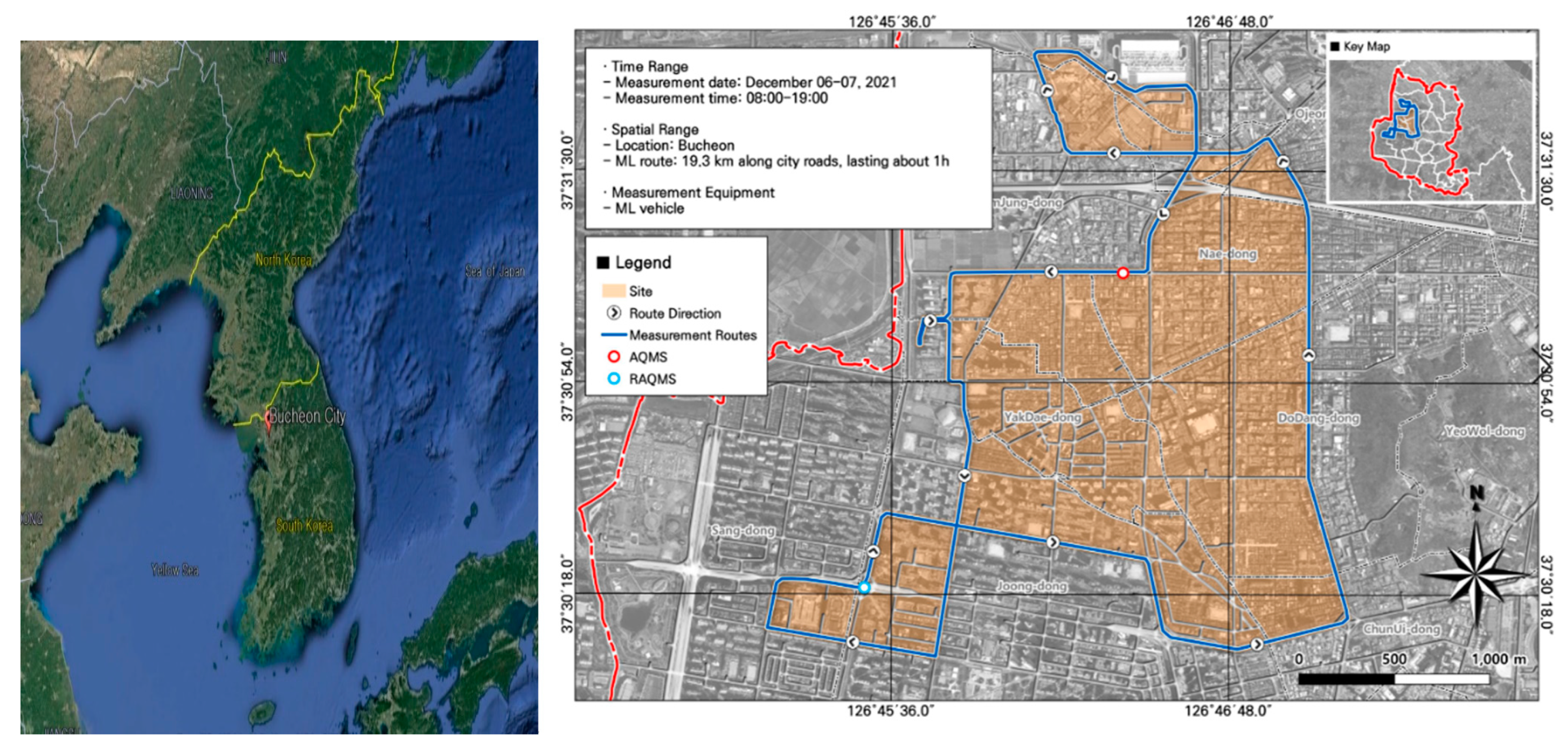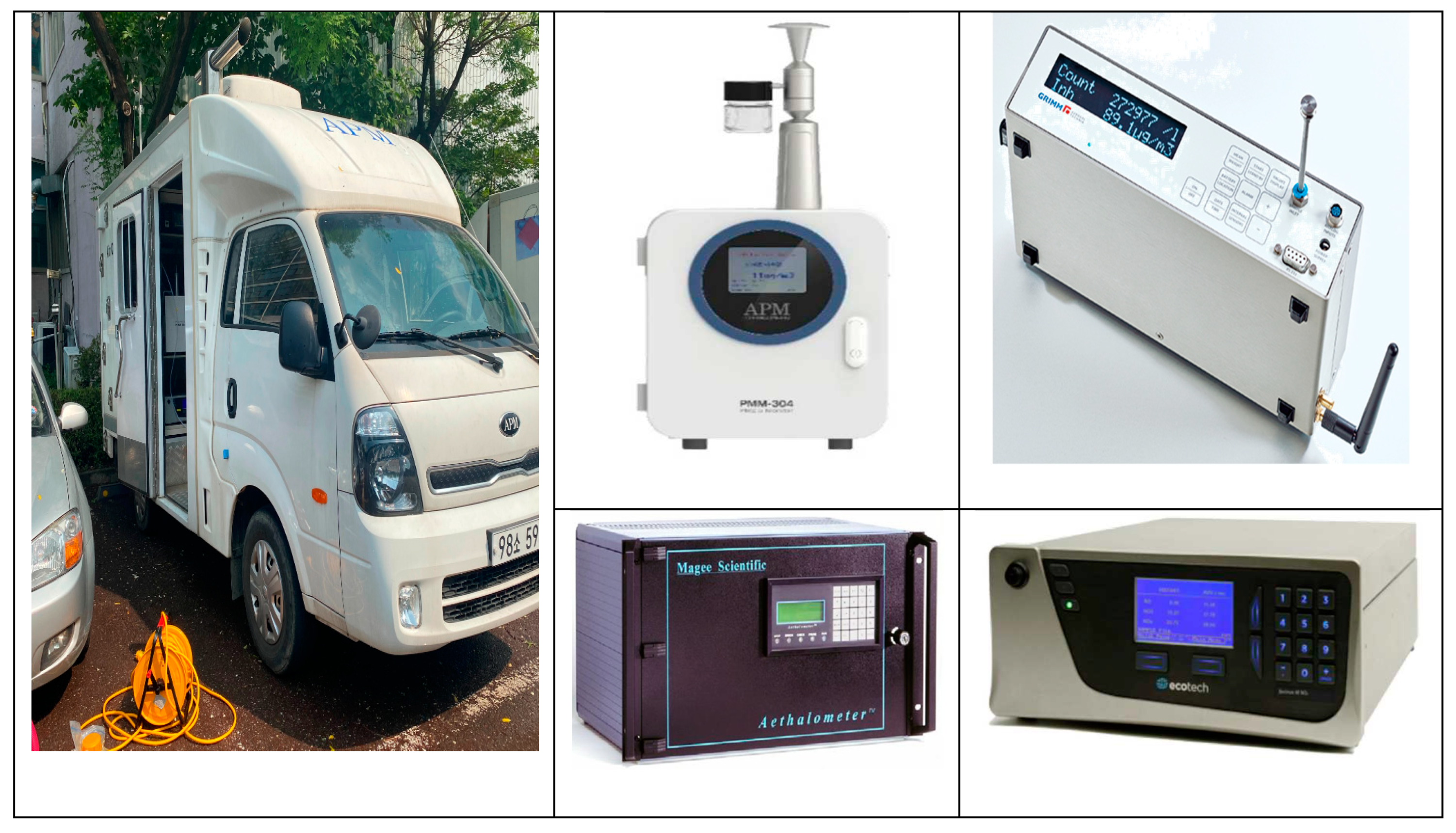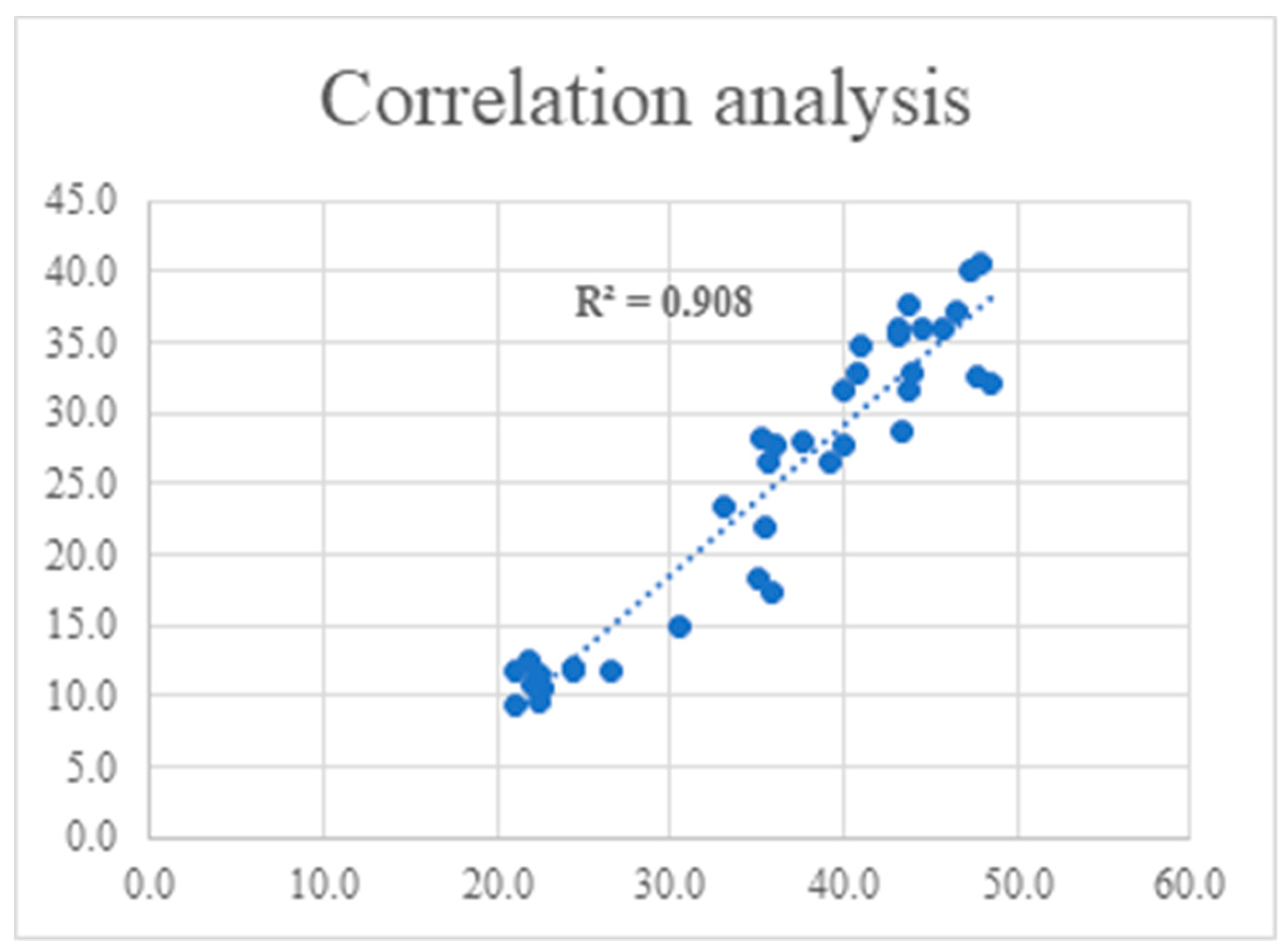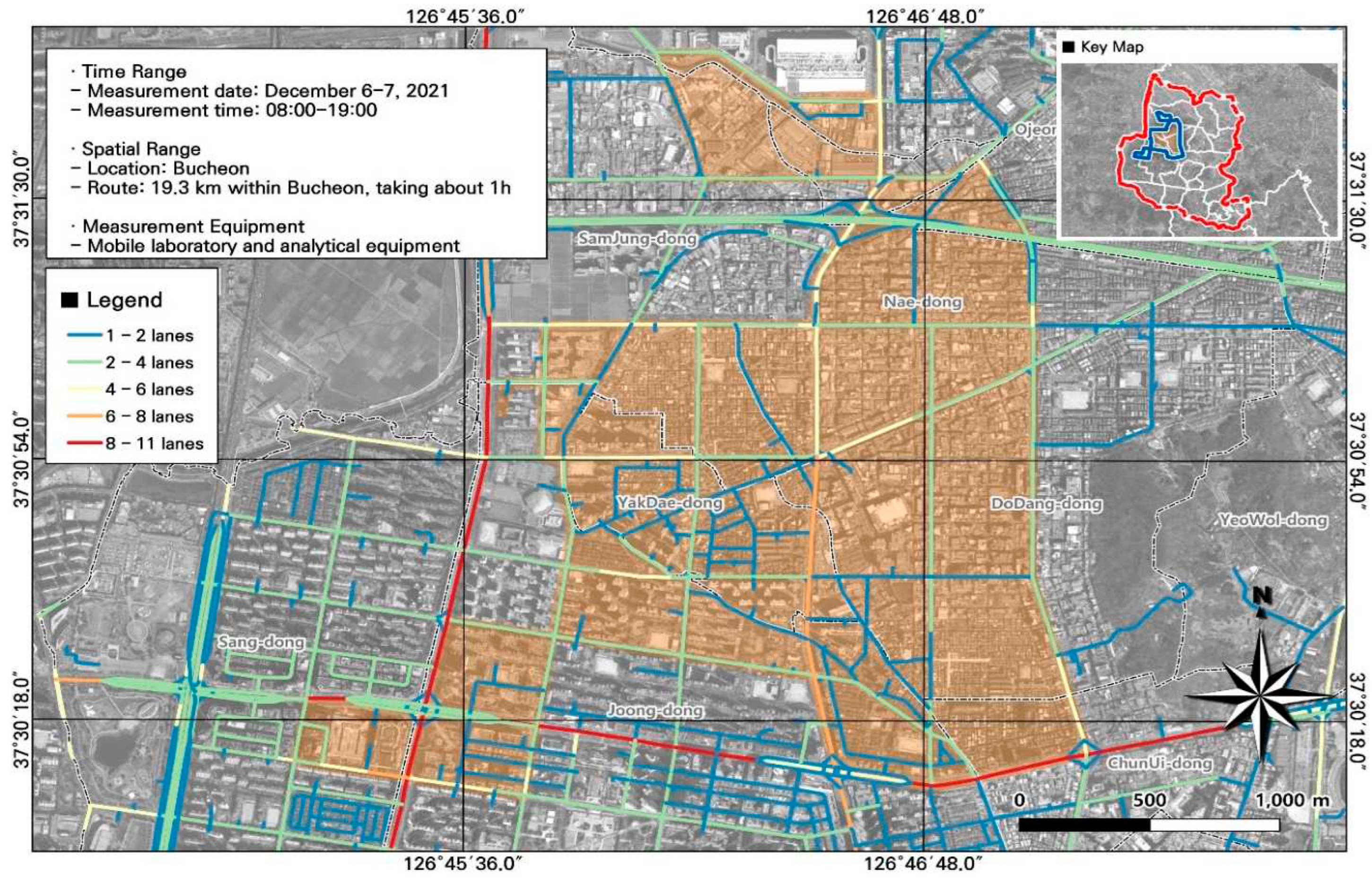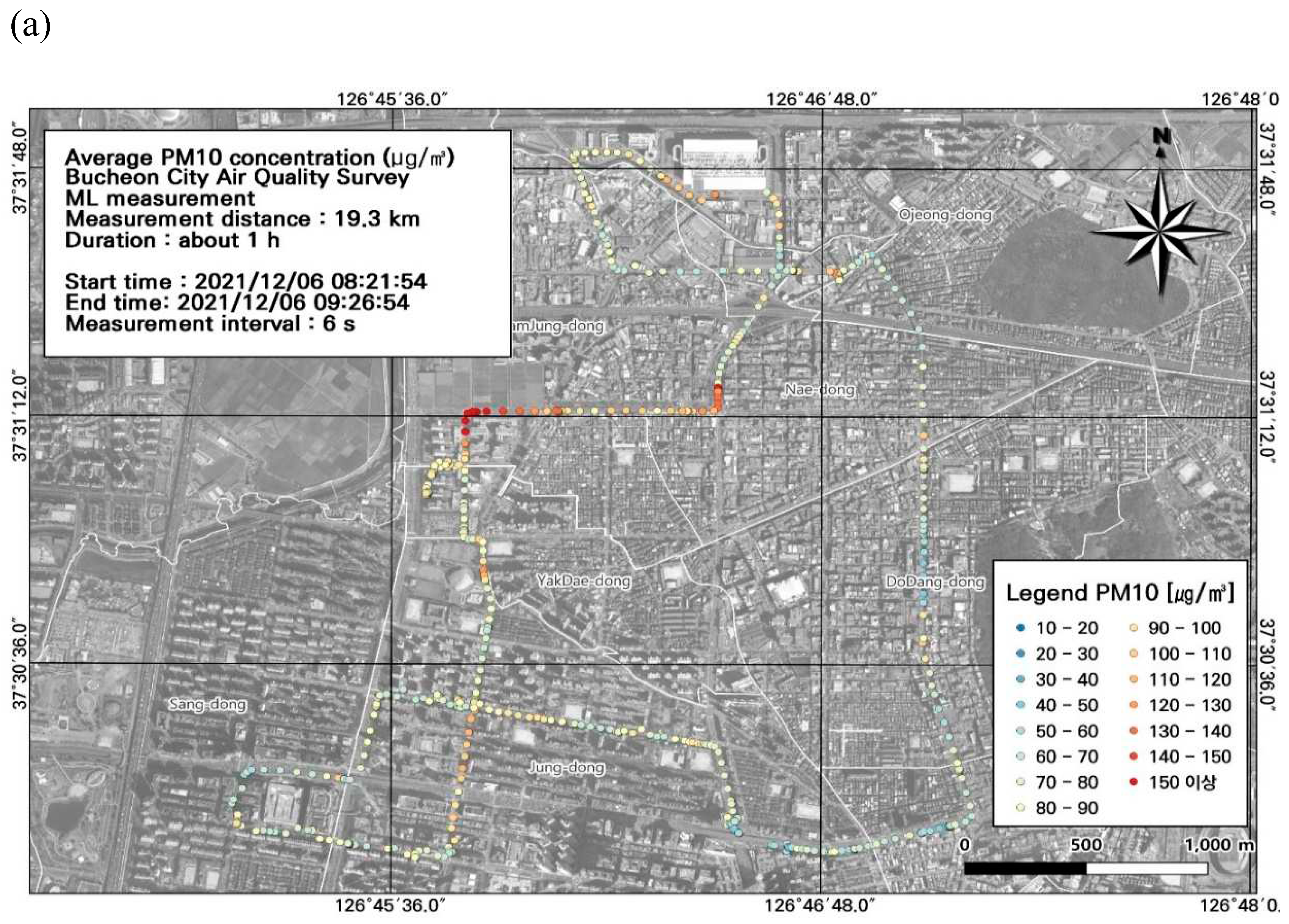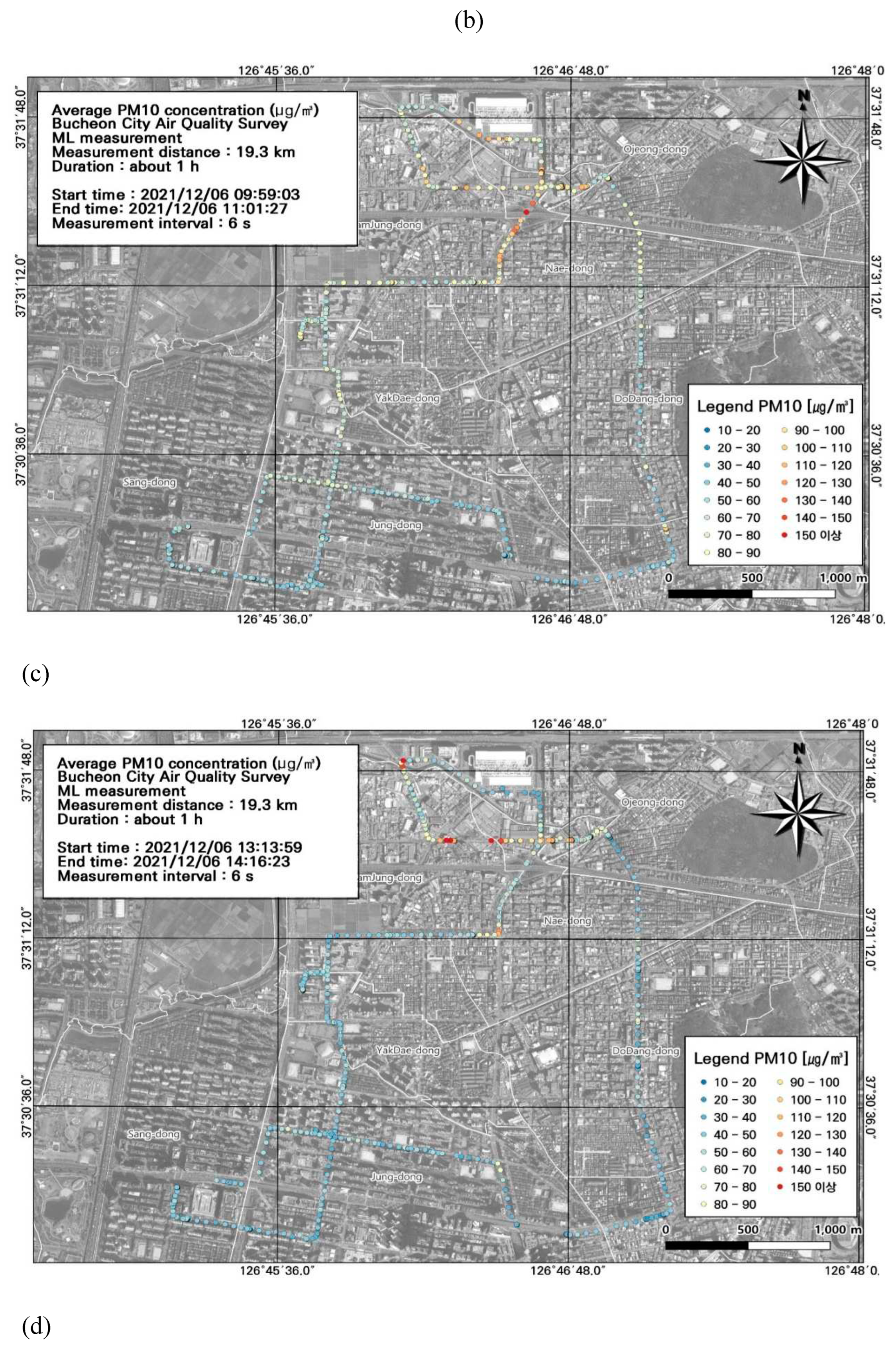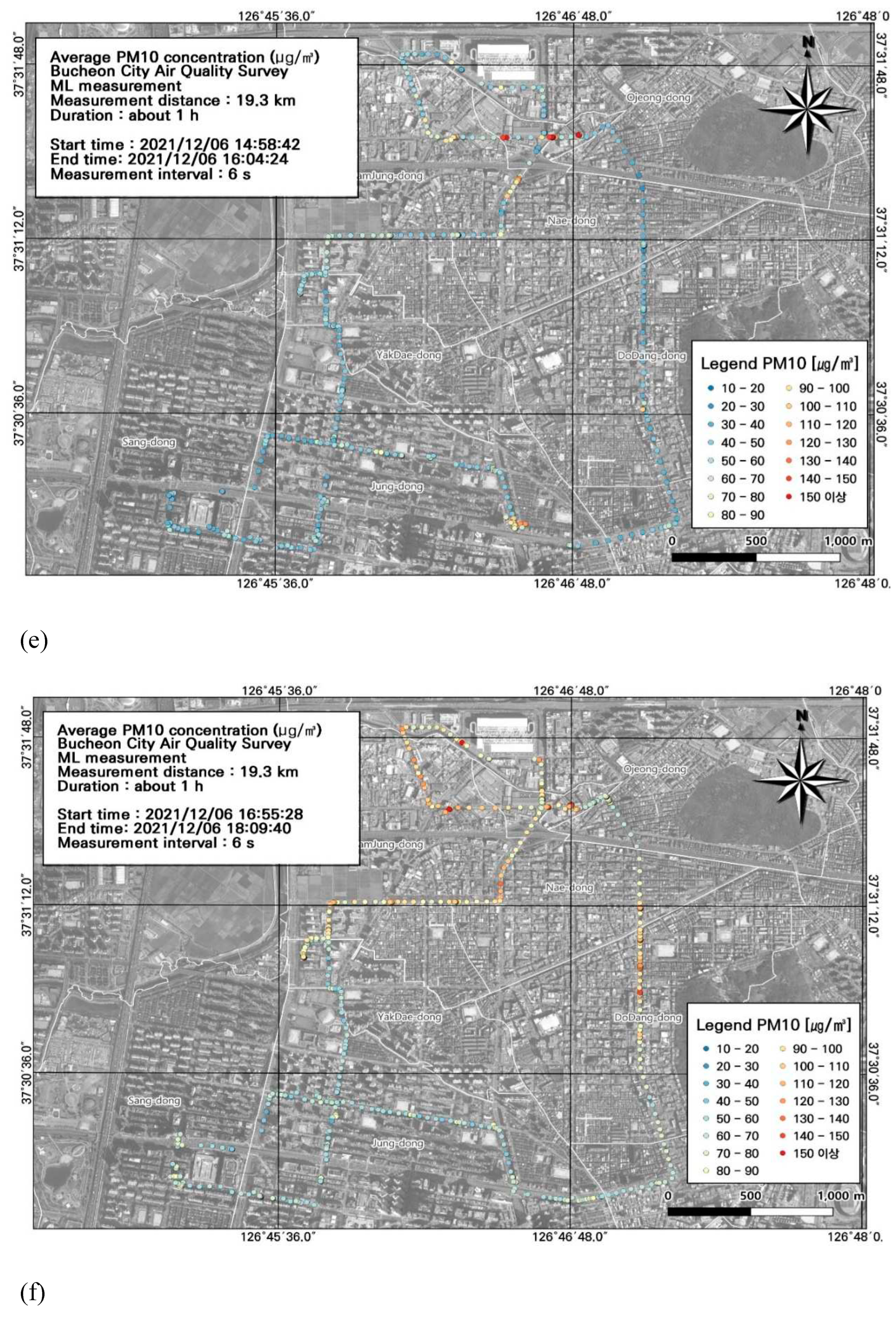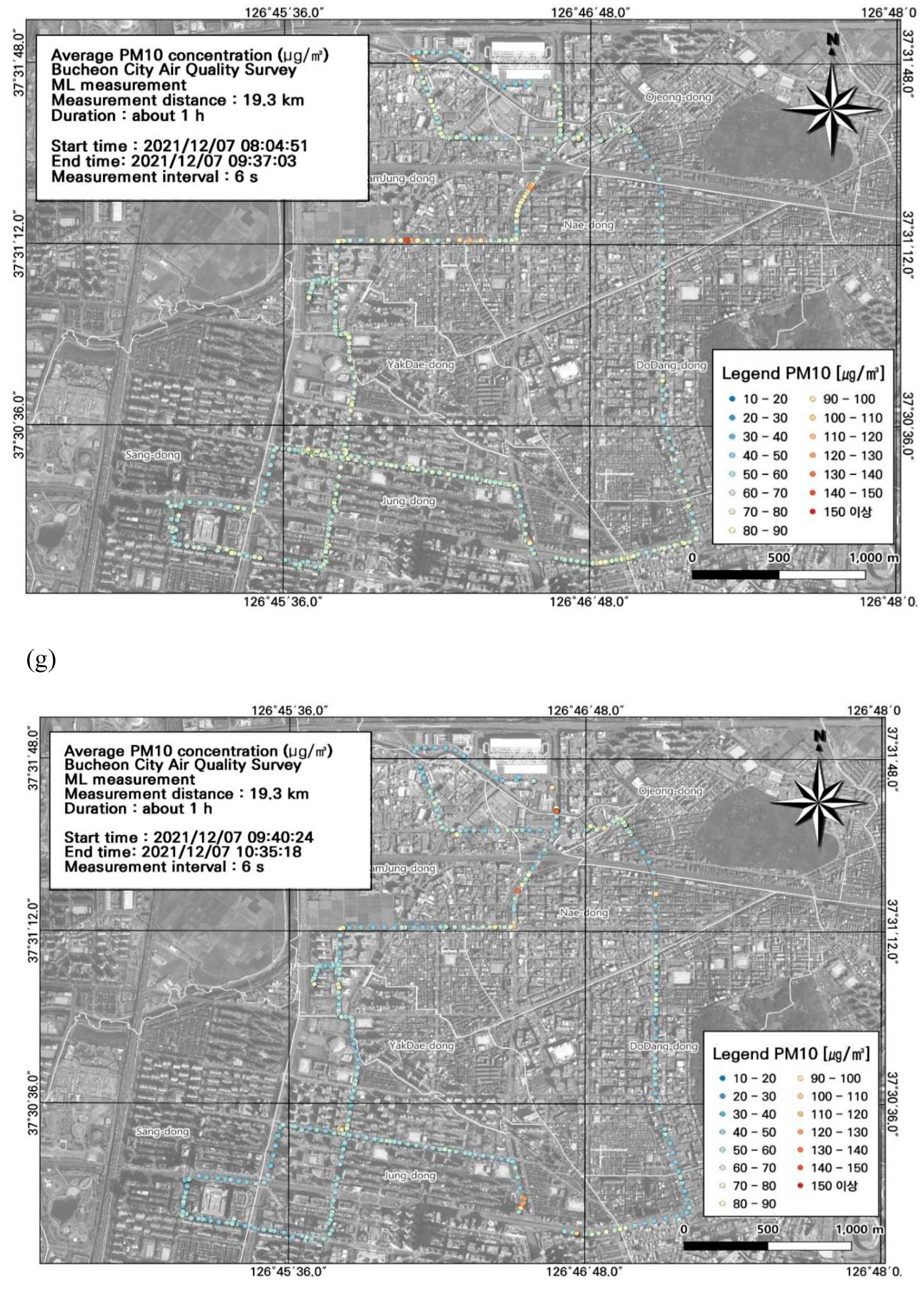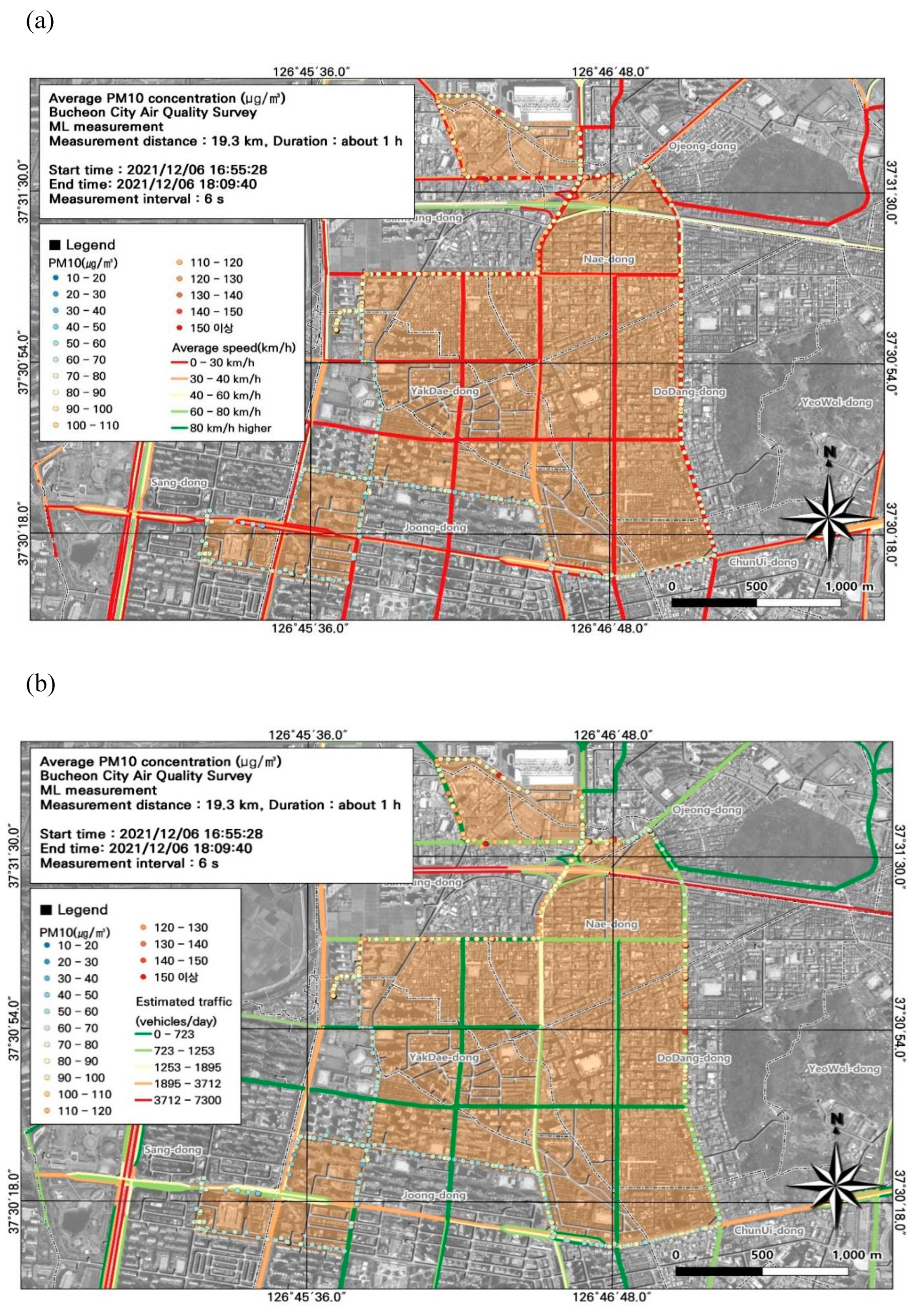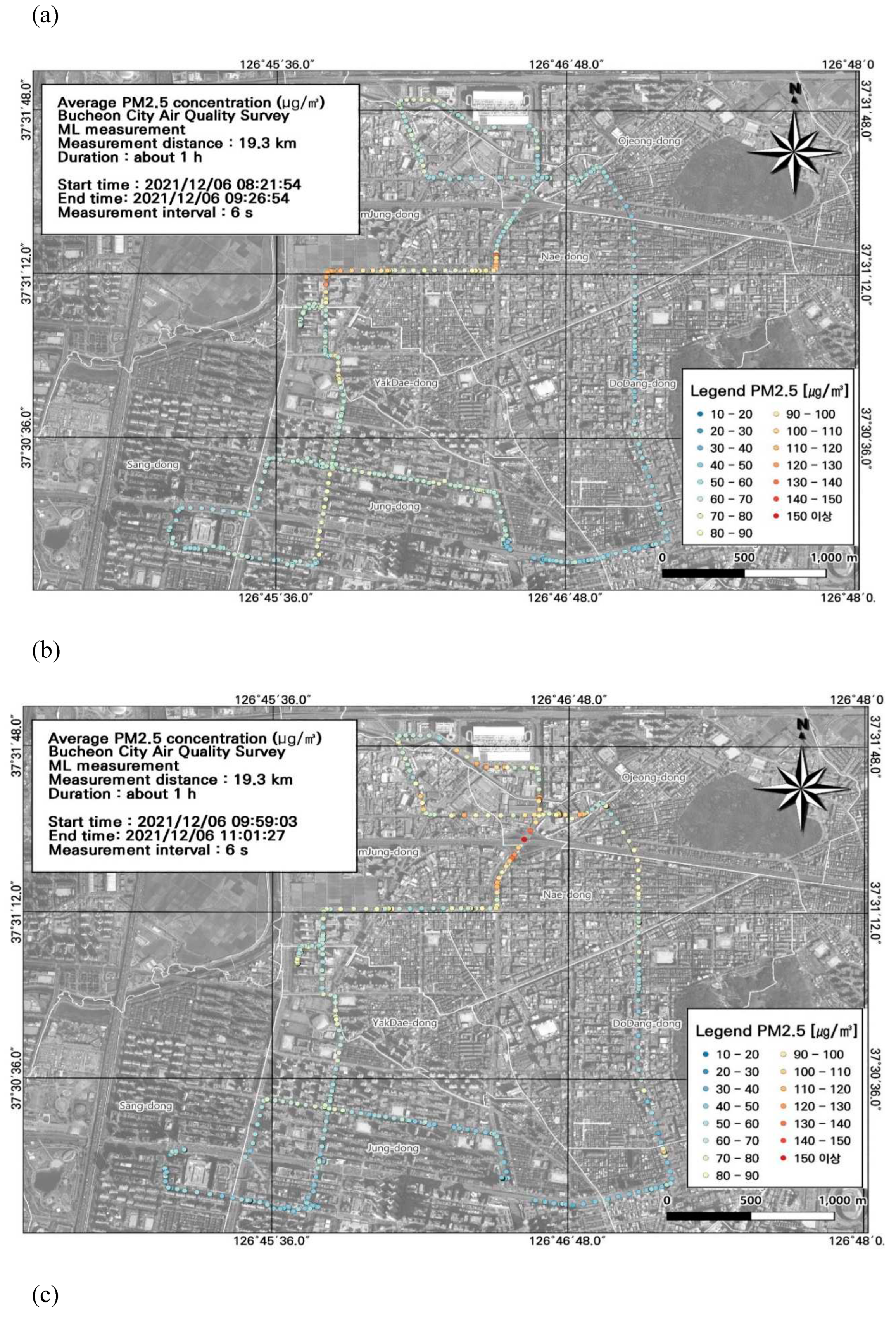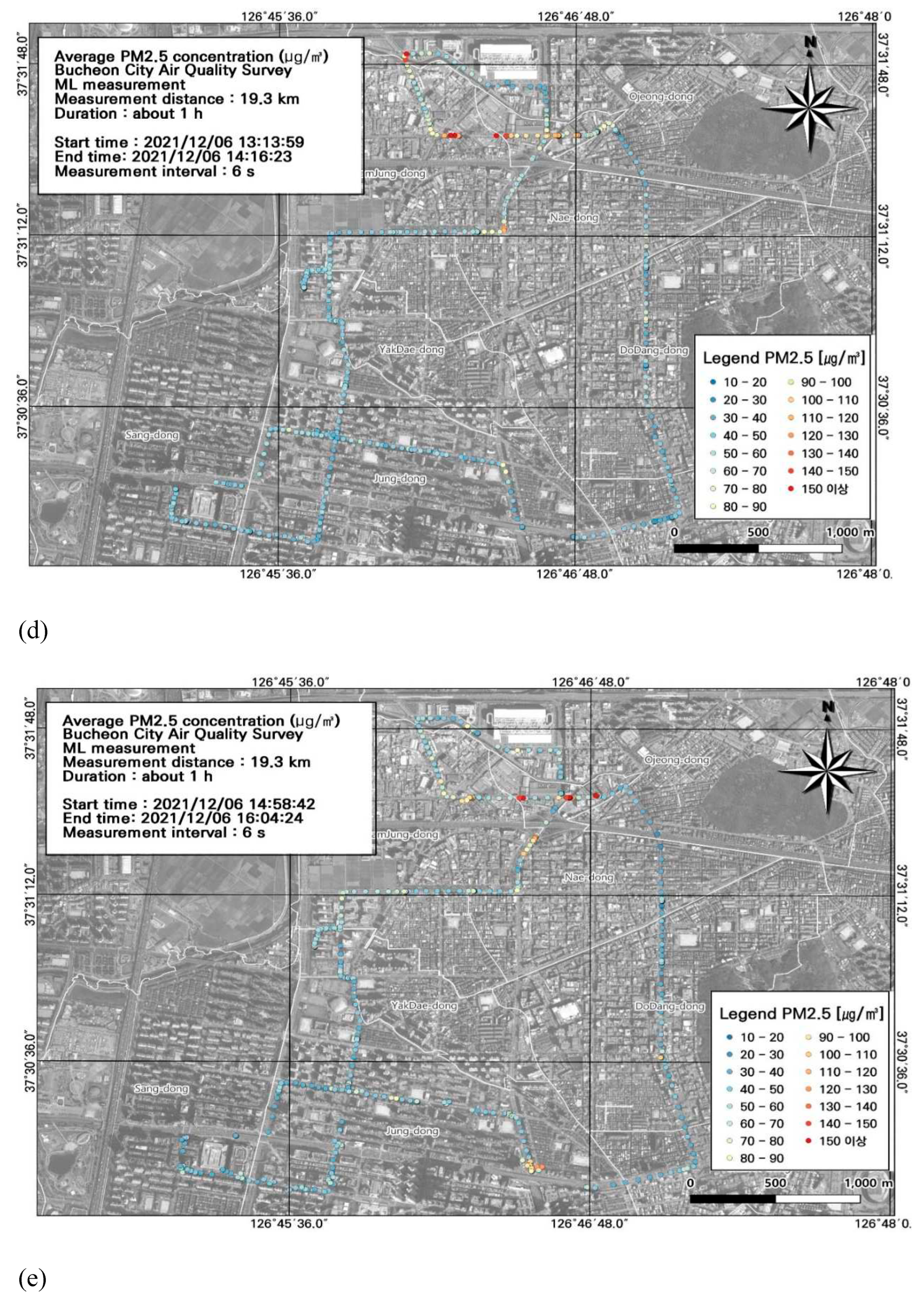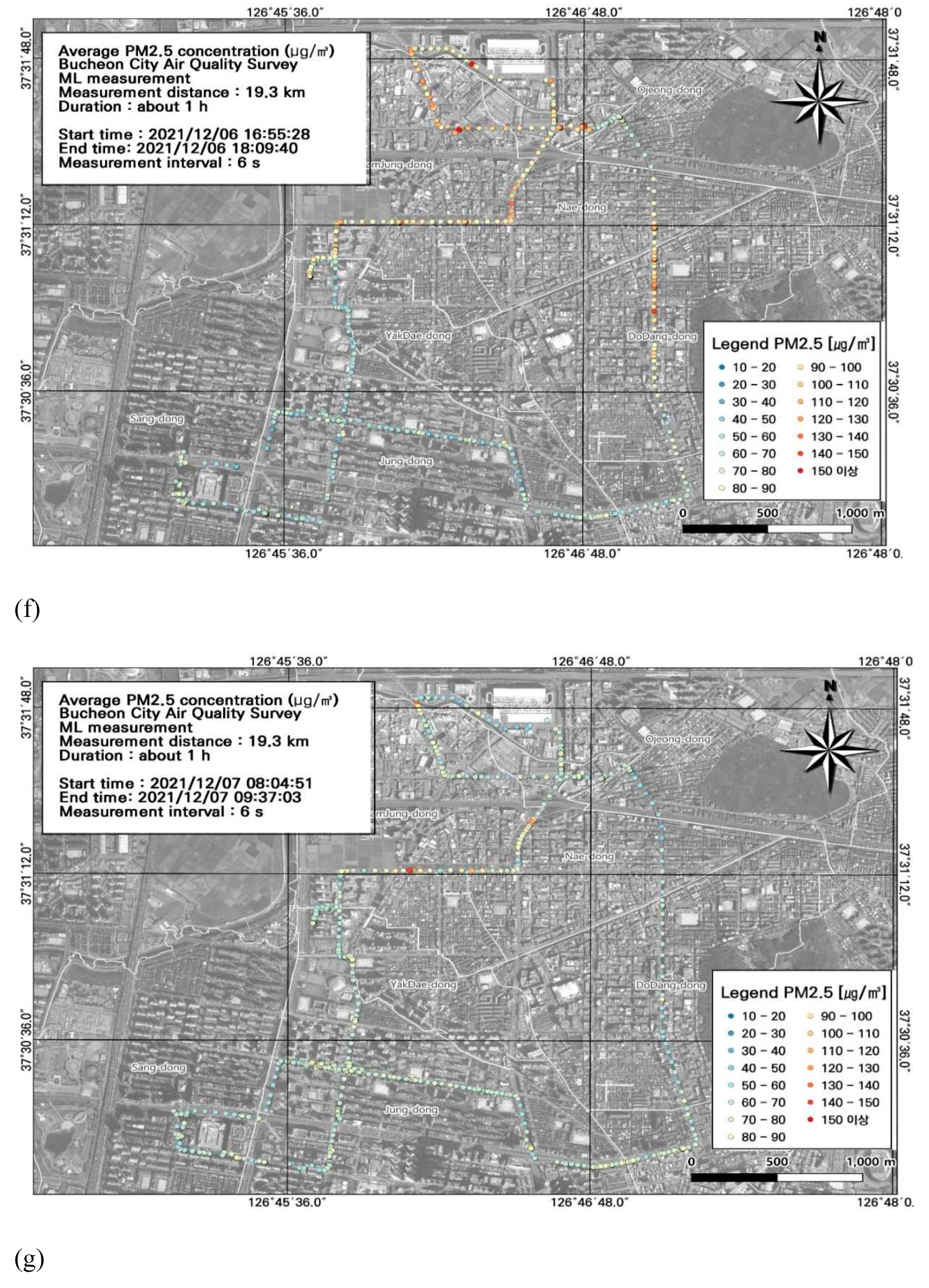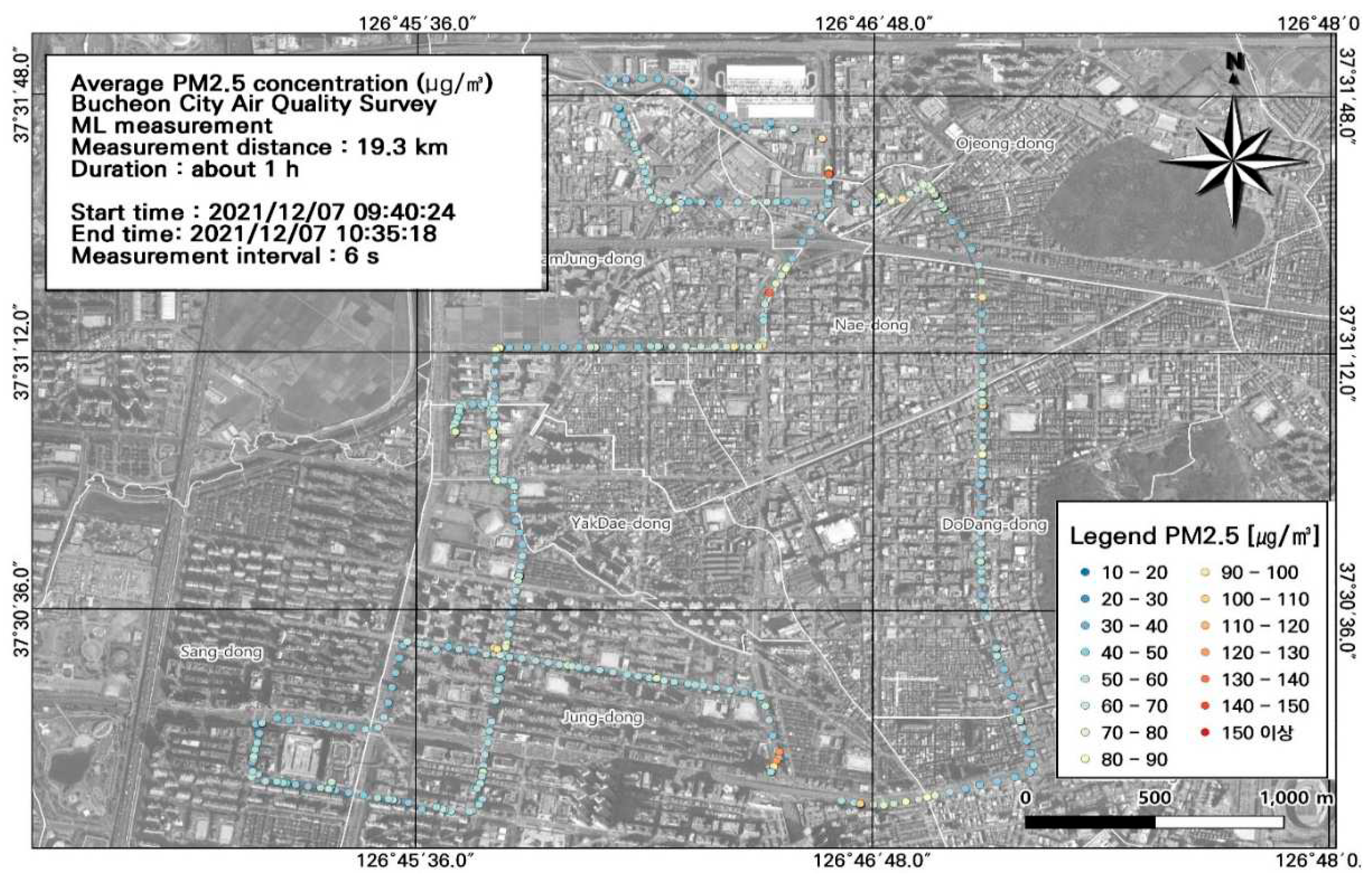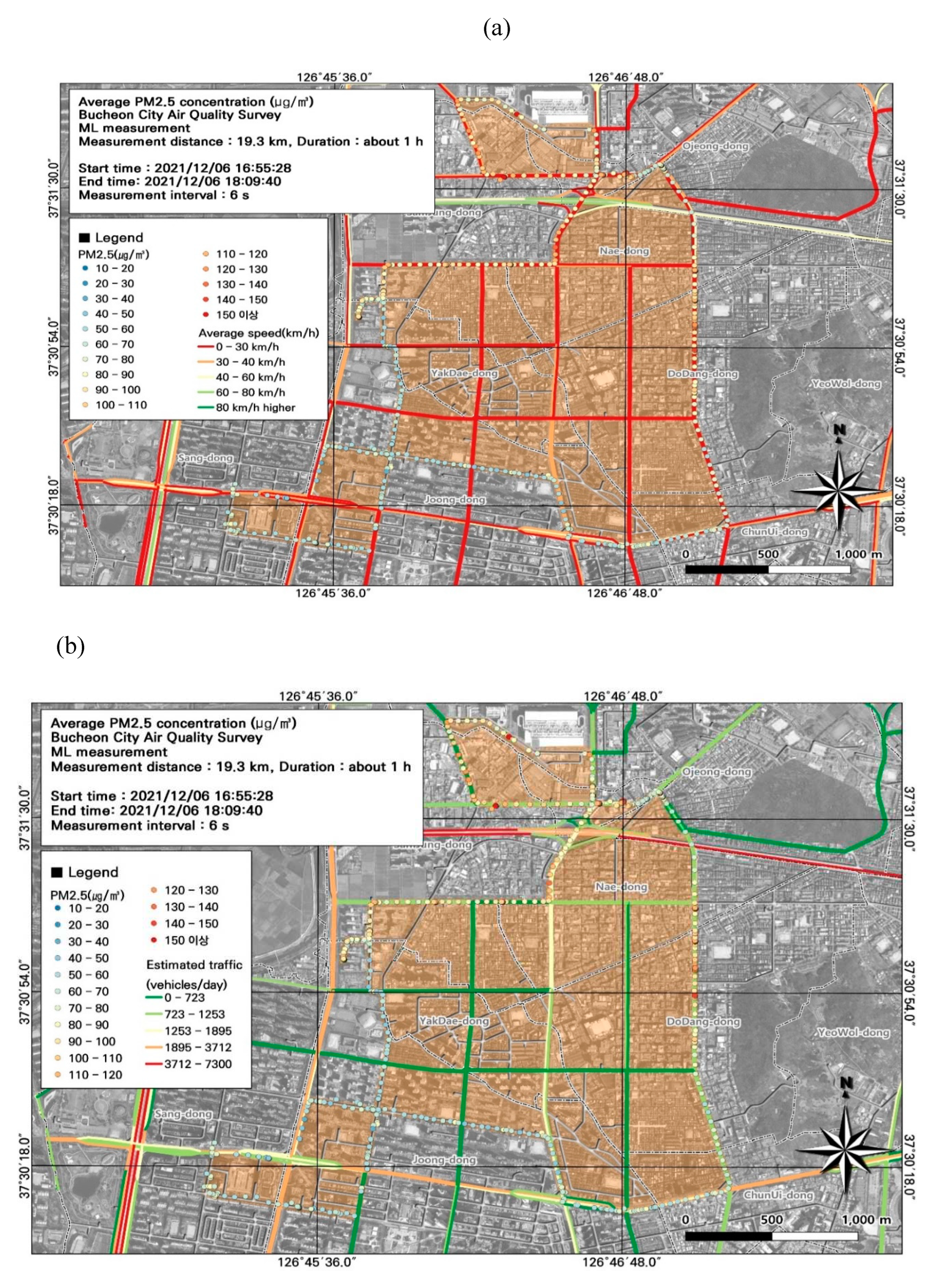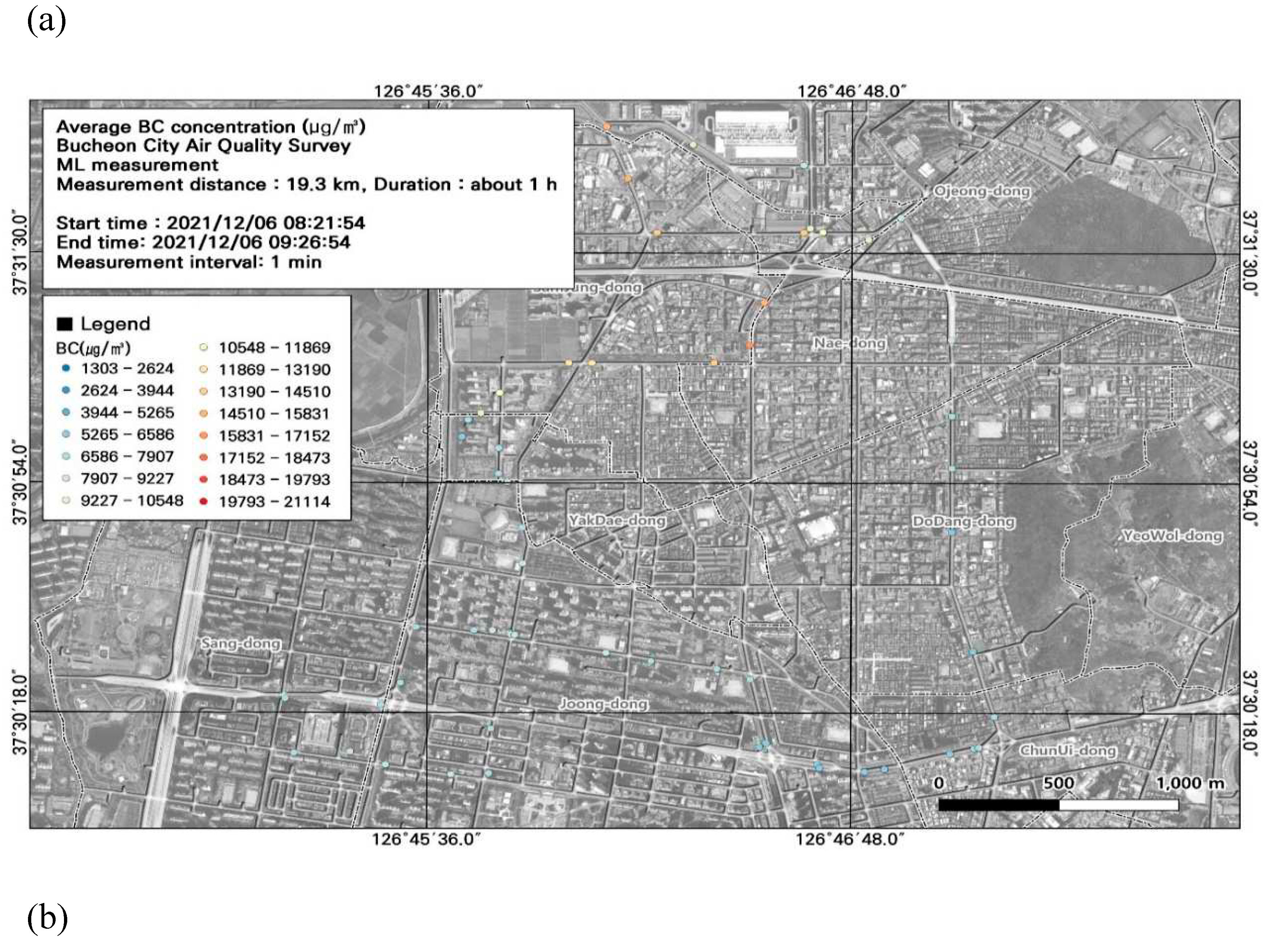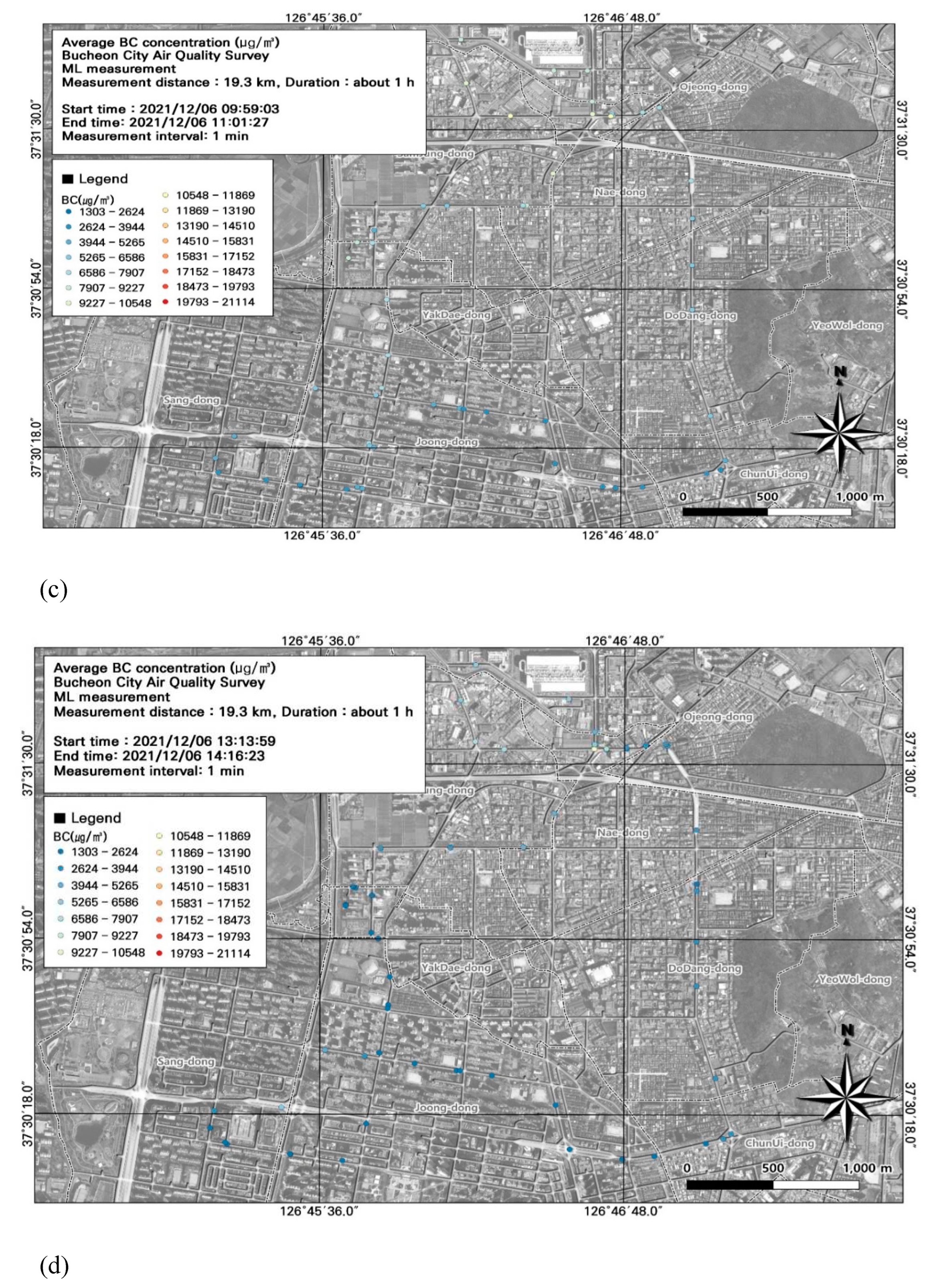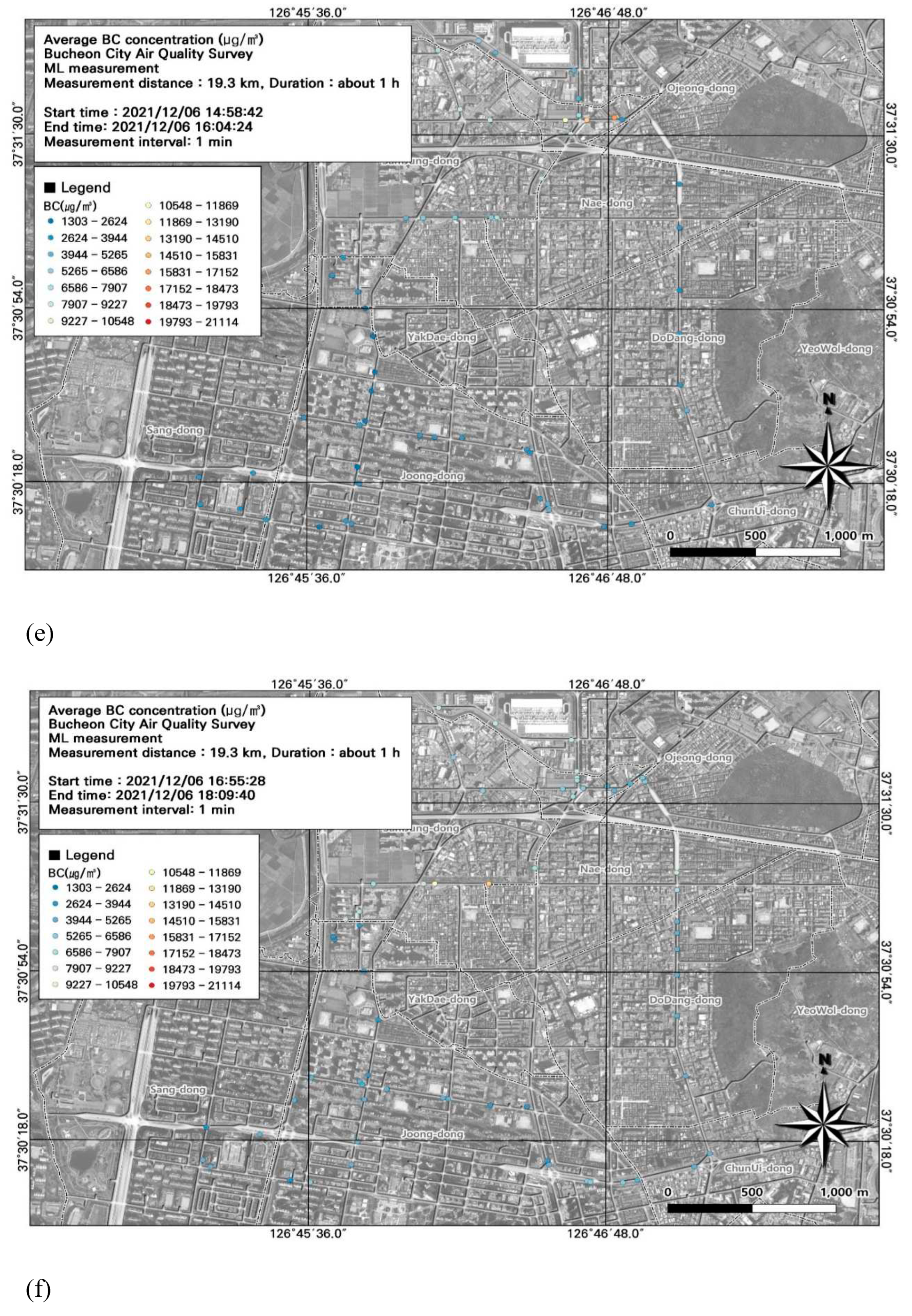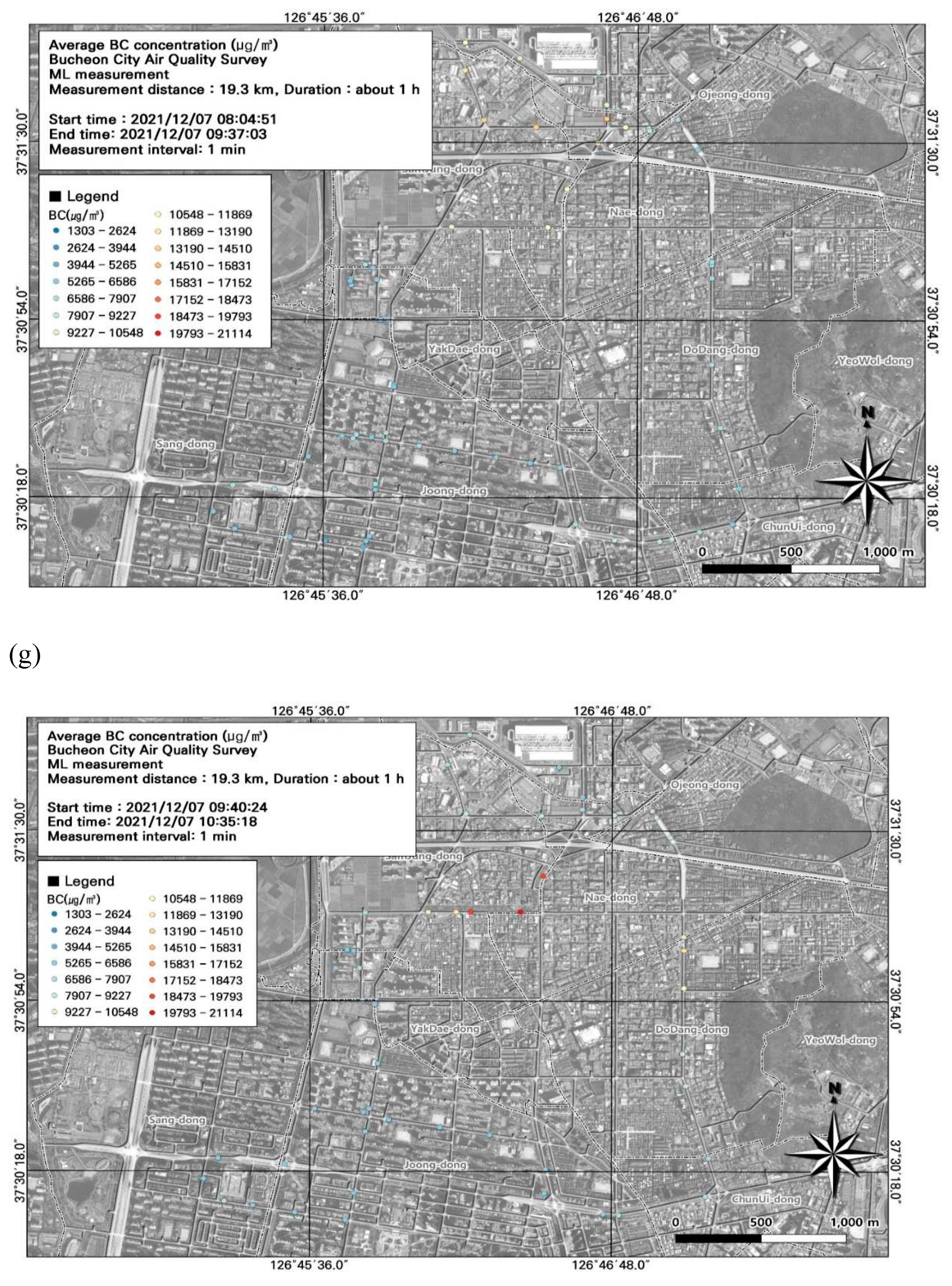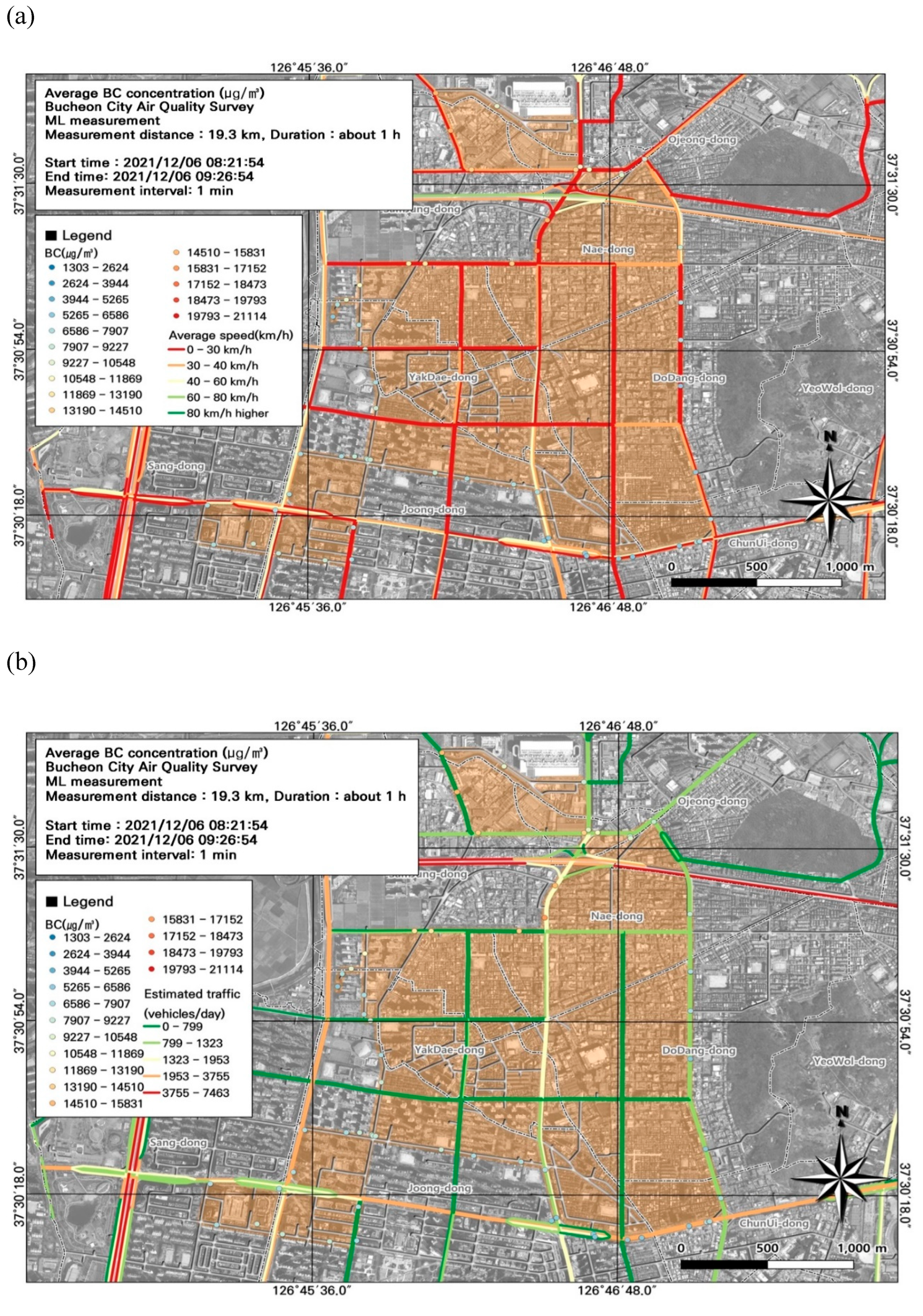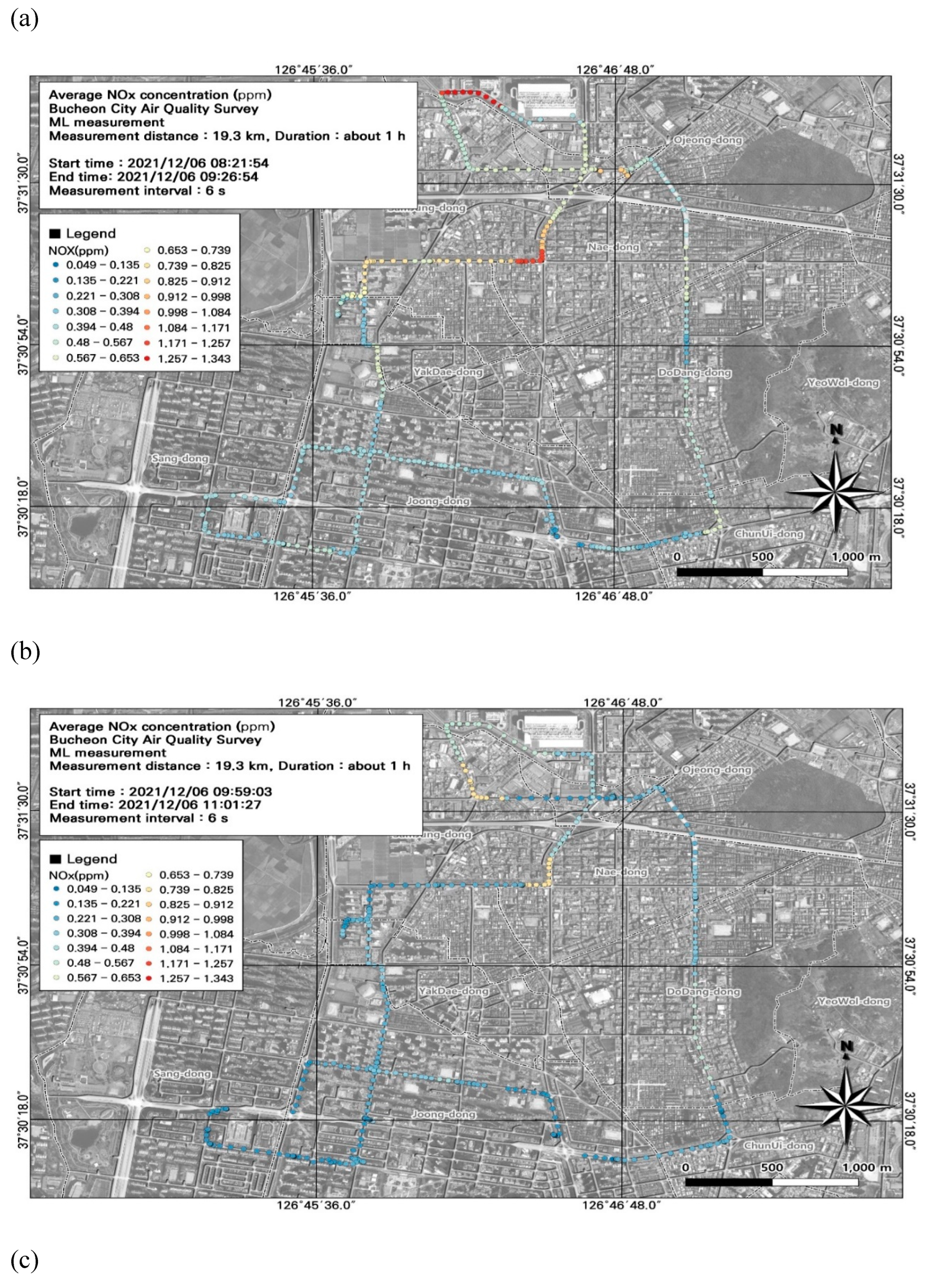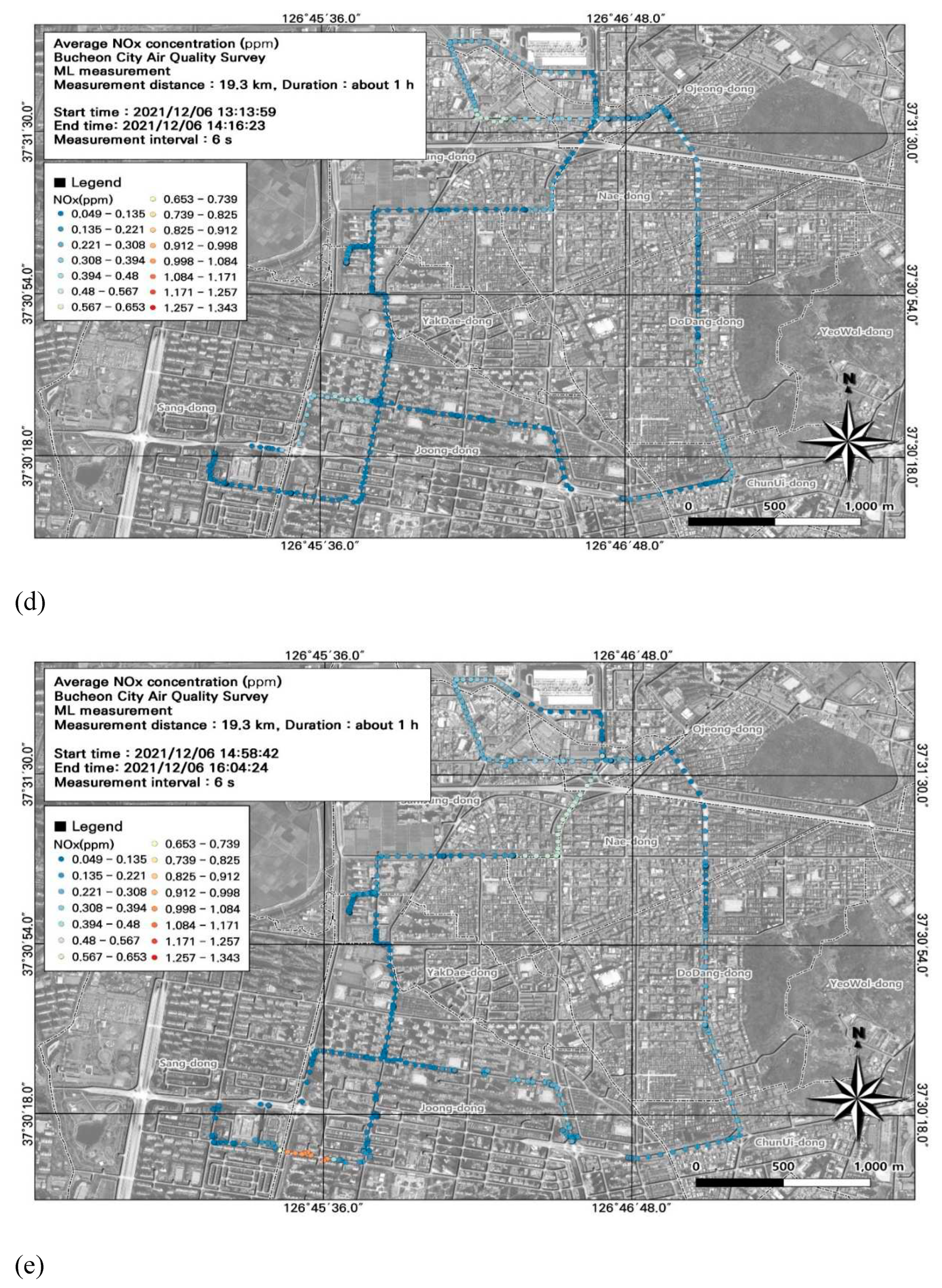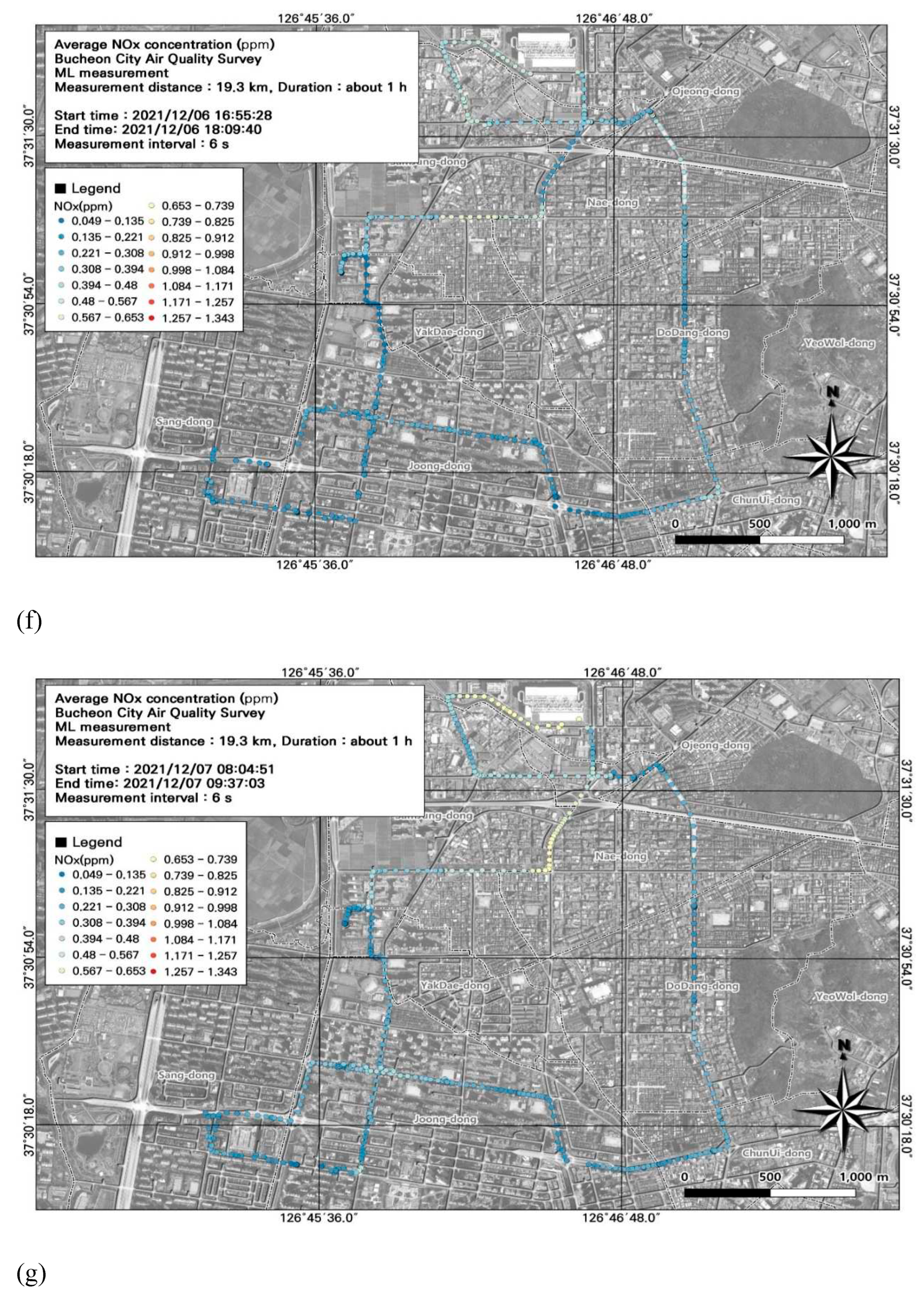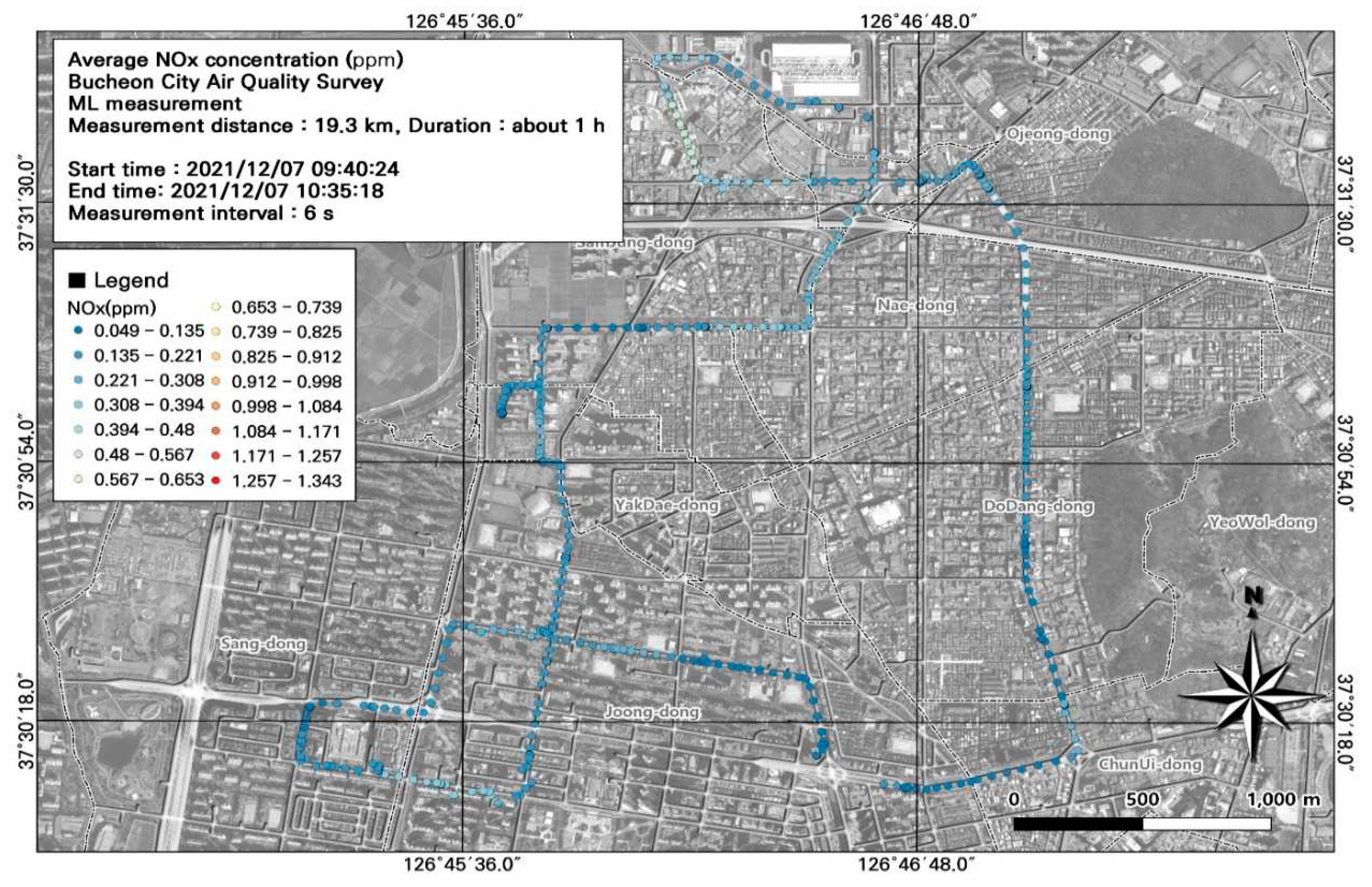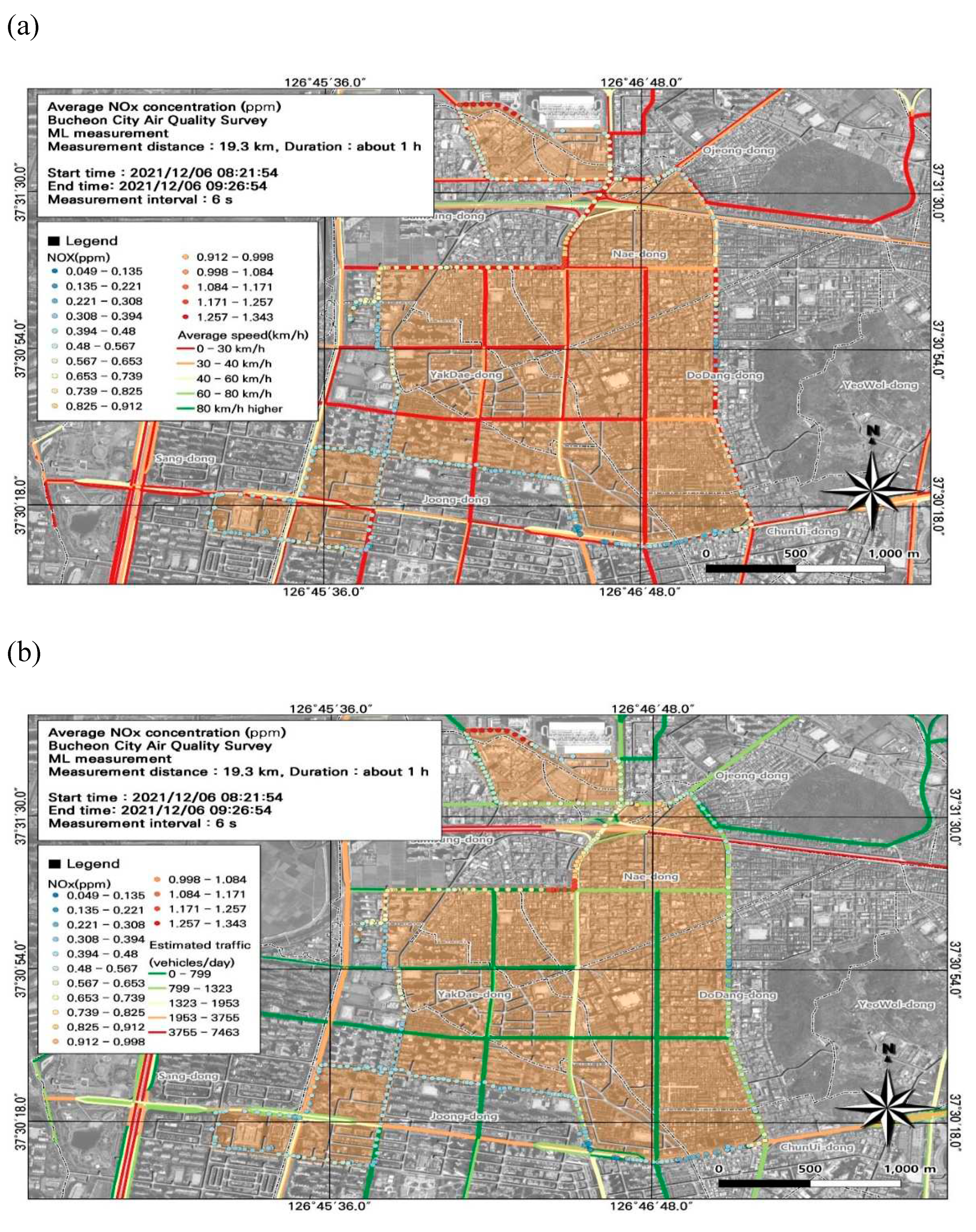1. Introduction
According to Statistics Korea (2023), more than half of the total Korean population lives in metropolitan areas (e.g., Seoul, Incheon, and Gyeonggi-do). Industrialization and urbanization lead to various social problems, such as high population densities, traffic congestion, and environmental pollution [
1,
2,
3,
4]. In particular, rapid densification frequently results in increased air pollutant emissions and increases in temperature, which in turn reduce air quality. Among air pollutants found in urban areas, major pollutants include nitrogen dioxide (NO
2), carbon moNO
xide (CO), fine particulate matter (PM
10, PM
2.5), black carbon (BC), volatile organic compounds, and ozone (O
3), which are generated through secondary reactions emitted from automobiles. These pollutants can cause respiratory, heart, and cerebrovascular diseases, and increase mortality rates [
4,
5,
6].
To enact effective air pollution reduction policies and measures, governments require spatiotemporal information about air pollutant characteristics. Local governments have started to continuously monitor the status of air pollutants (e.g., PM, O
3, and yellow dust) that threaten public health, and to secure the basic data necessary to establish air quality improvement measures. In Korea, air pollution monitoring networks include the urban air quality monitoring system (AQMS) and roadside air quality monitoring system (RAQMS) [
7,
22]. The AQMS monitors atmospheric salinity and environmental pollutants (e.g., SO
2, NO
2, CO, O
3, PM
10, and PM
2.5), as well as atmospheric and meteorological factors, in densely populated areas to improve air quality and environmental policies. The RAQMS is installed along high-traffic roadways to assess air quality along roads and manage the generation of pollutants emitted by vehicles. These systems provide air pollution data in real time that are available online, and help support air environment improvement plans by monitoring air pollution levels.
However, these networks have limitations. Both networks employ fixed measurement stations. Moreover, until 2016, most AQMS stations were installed only near metropolitan areas. Meanwhile, RAQMS stations are sparsely dispersed, so the system cannot capture air pollution or traffic volumes along many roads [
4,
8]. To compensate for these shortcomings, a mobile laboratory (ML) was introduced in 2011 in Korea to investigate the characteristics of roadside air pollution sources and the spatiotemporal distribution of air pollutants in urban areas [
4,
9,
10,
11,
12]. MLs are deployed in vehicles, and can survey roads not covered by the monitoring networks, analyze pollution levels in areas around industrial complexes, and conduct real-time surveys of redispersed road dust. These data can then be used to recommend location-specific measures to reduce air pollutant levels [
4,
5,
8,
13,
14,
15]. Most local governments in Korea are expanding the use of ML vehicles and drones to monitor air quality in areas without existing monitoring stations. However, in many cases, the collected data are not effectively visualized. To improve analyses of air pollution hotspots, there is a need to advance air pollution management through geographic information system (GIS)-based data visualization, digital twin models, and overlayed environmental factor data. In particular, GIS-based spatial analyses can enhance the interpretation of spatial phenomena and support rational, locally customized decision-making.
This study is the first to use ML-derived data to visualize the relationships among GIS-based environmental variables to improve air quality assessment and management. We used Bucheon, Korea, as the study area because of its high traffic volume and dense urban population. Using an ML equipped with real-time measurement equipment, we determined the spatiotemporal distributions of major air pollutants along a route that passed through residential, industrial, and industrial areas. Using GIS-based data visualization to identify pollution hotspots, we offer policy recommendations to improve local air management measures. This data acquisition and analysis method has broad applicability.
2. Materials and Methods
2.1. Research Site
As of 2020, Bucheon, Korea, has an area of 53.4 km2, a population of 831,701, and a population density of 15,575 people/km2. It has the highest population density in Gyeonggi-do, and contains a high concentration of residential, industrial, and industrial facilities. In addition, it is located between Seoul and Incheon, adjacent to the Gyeongin Expressway and the Capital Region First Ring Expressway; the traffic volume is 3.3 million people per day, which is very high compared to its population. There are four AQMS stations (Nae-dong, Sosabon-dong, Ojeong-dong, and Jung 2-dong) and one RAQMS station (Songnae-daero) in Bucheon. These stations measure a total of 10 items.
To select our study site, we reviewed the results of a hotspot analysis from the literature [
4]. The site was adjacent to the Gyeongin Expressway and the Capital Region First Ring Expressway, and also near the Nae-dong AQMS station and Songnae-daero RAQMS station. We selected a survey route that passed near industrial complexes and a specially managed road.
Figure 1.
Location of the study site, mobile laboratory (ML) route, and fixed air quality monitoring system (AQMS) and roadside air quality monitoring system (RAQMS) stations.
Figure 1.
Location of the study site, mobile laboratory (ML) route, and fixed air quality monitoring system (AQMS) and roadside air quality monitoring system (RAQMS) stations.
2.2. Experimental Methods
2.2.1. Mobile Laboratory
We used an ML to measure location information and air pollutants (
Figure 2). MLs enable the real-time measurement of spatiotemporal distributions and concentrations of air pollutants within a target area. However, there are time delays between the flow of pollutants into the inlet and measurement, difficulties in uniform absorption due to the physical characteristics of different pollutants, and separation from GPS data due to equipment sensitivity. Regardless, MLs are widely used, and the limitations can be compensated for according to the engineering design of the inlet [
4,
16,
17,
18,
19,
20].
For gas-phase pollutants, we followed the so-called Korean air pollution process test method. This method recommends using gravimetry and beta-ray absorption to measure fine dust in the atmosphere; however, for mobile measurements, we used light-scattering measurement methods to obtain faster responses. BC is used as an indicator of automobile emissions pollution; we measured BC using an AE51 aethalometer (Magee Scientific, Berkley, CA, USA). We also used a GPS system to determine the spatial coordinates of measurements according to vehicle movement to prevent measurement errors due to time differences among measurement devices.
Table 1.
Measurement items and devices.
Table 1.
Measurement items and devices.
| Measurement item |
Instrument |
Measurement range
|
Interval
|
| Latitude, Longitude, Altitude, Speed |
GPS system |
- |
1 s |
| PM10, PM2.5
|
Grimm 11-D
(Grimm Aerosol Technik) |
0.253–35.15 μm |
6 s |
| PM2.5
|
PMM-304 (APM) |
0–200 µg/m3
|
60 s (1 m) |
| NOx
|
Serinus 40 (Ecotech) |
0–20 ppm |
1 s |
| Black carbon |
AE51 aethalometer
(Magee Scientific) |
0–1000 µg/m3
|
60 s (1 m) |
PM was measured using a PMM-304 (APM, Bucheon, Korea) and Grimm 11-D (Grimm Aerosol Technik, Berlin, Germany). The PMM-304 measured PM
2.5 at 60 s intervals, and the Grimm 11-D measured PM
2.5 and PM
10 at 6 s intervals. Comparison of the two datasets revealed a high correlation (R
2 = 0.908) (
Figure 3). Accordingly, for the spatiotemporal analysis, we used data from the Grimm 11-D, which were collected at a shorter interval.
The ML vehicle was remodeled after approval of the structural changes. The inside of the vehicle was equipped with equipment and a generator to measure PM. An intake port was installed on the roof of the vehicle to collect air samples while driving; it was designed to collect particulate pollutants at a constant velocity. At vehicle speeds of 0–70 km/h, we confirmed the average speed to have a rate of change of less than 0.8–2.0%; therefore, measurements in traffic were conducted within this speed range as much as possible [
21].
2.2.2. Measurement Procedure
The mobile measurements were taken along a predetermined route, which started and ended at the Bucheon Technopark, Yakdae-dong; before operation, the equipment was inspected and the battery was charged.
Beginning at the Technopark, the route passed through Gyenam Park and the Eugene ready-mixed concrete complex, and near Songnae-daero, Gilju-ro, Gyenam-ro, and the Gyeongin Expressway. The route was 19.3 km, and took about 1 h. Because fine dust concentrations are highest from December to March, the study was conducted on December 6 and 7. We conducted seven sets of mobile measurements (five on December 6, and five on December 7) during regular commuting and work hours. To ensure a constant velocity of PM by the inlet, the driving speed was maintained around 20–30 km/h.
2.2.3. GIS Analysis
We used the open-source software QGIS ver. 3.32 to analyze the spatial and temporal distributions of air pollution in Bucheon. The GIS analysis was based on the GPS-derived coordinates of the ML and the time and concentration data for the measured pollutants.
Most of the study area was urbanized, so land-cover variables were limited. Instead, we collected data on road information, vehicle speed (e.g., average speed during congestion and maximum speed), and traffic volume as important variables to assess the particulate and gaseous pollutants generated on roads. We used openly available data in the View-T service from the National Transport Database, Korea Transport Institute (
Figure 4).
3. Results
3.1. Particulate Pollution in Bucheon
We performed a comparative analysis of the ML-derived data from the study area and data from nearby AQMS and RAQMS stations (
Table 2). The area included residential and industrial complexes, so the spatial distributions of pollutant concentrations varied markedly.
The ML-measured PM10 (78.7 ± 26.2 µg/m3) and PM2.5 (55.7 ± 13.0 µg/m3) concentrations were similar to those of the AQMS, but differed substantially from those of the RAQMS (15–17 µg/m3). Sources of particulate pollutants include not only automobile exhaust but also re-dispersed road particulates, pollen, and long-range transport from other regions. The urban particulate (PM2.5, PM10) levels from the AQMS were similar to the ML-derived roadside concentrations, indicating that there were no additional influencing factors along the road. Real-time BC measurements along roads have recently been used as an indicator of automobile emissions; the average BC concentration was 6205.7 ± 3020.1 µg/m3 as measured by the ML. The AQMS and RAQMS stations do not measure BC, so comparison was not possible.
The ML-derived concentrations of the gaseous pollutants NO, NO2, and NOx were 0.21 ± 0.16 ppm, 0.07 ± 0.03 ppm, and 0.28 ± 0.18 ppm, respectively. Automobile exhaust is the main source of NOx emissions in cities; therefore, their emissions are often higher along roads than at urban measurement stations. Accordingly, the ML-measured NO2 levels in this study were higher than those from the AQMS and RAQMS.
Urban pollution levels are much higher near high-volume intersections than surrounding areas, and decrease with increasing distance from roads. The study route included a specially managed road, so we could assess whether particulate and gaseous pollutants were correlated with road emissions sources.
3.2. Spatiotemporal Patterns of PM2.5 and PM10 Concentrations
Among the seven measurement runs, the highest PM10 concentration (91.8 ± 17.6 µg/m3) was detected during typical evening rush hour, followed by morning rush hour (79.6 ± 19.7 µg/m3). The spatiotemporal distributions confirmed high PM10 concentrations during commuting hours in the areas near Nae-dong, Gyeongin-ro, and Ojeong-dong ready-mix concrete complex. During morning rush hour, the highest PM10 concentration was 190 µg/m3 in the Nae-dong and Gyeongin-ro areas. During evening rush hour, the highest PM10 concentration was 200.7 µg/m3 in the areas of Nae-dong, Gyeongin-ro, and Ojeong-dong ready-mix concrete complex. These findings confirm high contributions of roadside mobile emissions to air pollution; accordingly, careful management of these areas is necessary during commuting hours.
The 1 h average measurements from the AQMS can be checked in real time, but the measurement interval limits their comparison with nearby traffic variables. To overcome this limitation, we used the ML-derived pollutant concentrations (collected in the order of seconds) to compare the spatiotemporal distributions with traffic variables.
Overall, the study area had high PM
10 concentrations, and we performed a spatial analysis of the data collected during work hours (
Figure 5), when concentrations were high along the entire route (
Figure 6). Based on the ML vehicle speed, we found that most of the route experienced traffic congestion during commuting hours, during which time the average speed was 0–30 km/h. The PM
10 concentration was highest during morning rush hour in the Nae-dong and Gyeongin-ro areas (190 µg/m
3), and during evening rush hour in the Nae-dong, Gyeongin-ro, and Ojeong-dong ready-mix concrete complex areas (200.7 µg/m
3). Comparison of the estimated traffic volume and PM
10 concentration values confirmed that the traffic volume was elevated (723–1253 vehicles/day) near Nae-dong and Gyeongin-ro, where PM
10 concentrations were relatively high. These findings indicate that road emissions influence PM
10 concentrations.
Among the seven ML datasets of PM
2.5 concentrations, the highest average concentrations were measured during the two morning rush hours (day 1: 62.7 ± 3.0 µg/m
3; day 2: 59.5 ± 6.8 µg/m
3) (
Figure 7), followed by the evening rush hour (59.2 ± 8.8 µg/m
3) (
Figure 5). During commuting hours, the highest PM
2.5 concentration was 132.9 µg/m
3. During work hours, the highest PM
2.5 concentration was 161.7 µg/m
3 in the areas of Nae-dong, Gyeongin-ro, and Ojeong-dong ready-mix concrete complex. Similar to the PM
10 results, these findings confirmed high PM
2.5 concentrations during commuting hours, and thus high contributions from mobile emissions, particularly near Nae-dong, Gyeongin-ro, and Ojeong-dong ready-mix concrete complex. Accordingly, careful management of these areas is necessary during commuting hours.
Overall, the study area had high PM
2.5 concentrations, and we performed a spatial analysis of the data collected during work hours (
Figure 7), when concentrations were relatively high along the entire route (
Figure 8). As noted for the PM
10 results, most of the route was congested during commuting hours, and the ML vehicle average speed was 0–30 km/h. The highest PM
2.5 concentration during commuting hours (132.9 µg/m
3) was measured in the Nae-dong and Gyeongin-ro areas, and during work hours (161.7 µg/m
3) was measured in the areas of Nae-dong, Gyeongin-ro, and Ojeong-dong ready-mix concrete complex. Comparison of the PM
2.5 concentrations with estimated traffic volume revealed high PM
2.5 concentrations near areas with elevated traffic volumes (723–1253 vehicles/day), i.e., Nae-dong and Gyeongin-ro. The traffic volume was also relatively high near the Ojeong-dong ready-mix concrete complex, which experienced high PM
2.5 concentrations. Thus, road emissions impact both PM
10 and PM
2.5 concentrations.
To examine the impact of automobiles on the spatiotemporal distributions of PM10 and PM2.5 concentrations, it is necessary to comprehensively review road and traffic volume variables using GIS. Such analyses allow hotspots to be identified for targeted air quality management measures.
3.3. Spatiotemporal Patterns of BC Concentrations
Among the seven ML datasets, the highest average BC concentration was measured during the morning rush hour (8722.0 ± 2660.7 µg/m
3) (
Figure 9), followed by the evening rush hour (7889.2 ± 3283.4 µg/m
3). During commuting hours, the highest measurement was 16,139 µg/m
3 at the Nae-dong intersection on December 6; on December 7, the highest daily BC concentration was 14,716 µg/m
3. Overall, BC concentrations were higher during commuting hours. BC is a particulate pollutant used as an indicator of automobile emissions. However, BC concentrations are measured over 1 min intervals, and only average levels for the entire interval can be measured. Accordingly, it is necessary to consider the spatiotemporal distribution of BC in combination with PM, which can be measured at shorter intervals.
We subsequently performed a spatial analysis using the data during morning rush hour (
Figure 9) to identify areas with particularly high BC concentrations (
Figure 10). Because BC concentrations were measured at 1 min intervals, we could not perform a detailed comparison. Traffic was congested along the entire study route, and the average traffic speed was 0–30 km/h. Based on the comparison of traffic volume estimates and BC concentrations, the areas near Nae-dong and Gyeongin-ro had relatively high BC concentrations, and experienced elevated traffic volumes of 1323–1953 vehicles/day. Moreover, BC concentrations were relatively high at intersections. These findings highlight the importance of examining BC along with PM
10 and PM
2.5 when investigating vehicle emissions.
3.4. Spatiotemporal Patterns of NOx Concentrations
NO
x concentrations are widely used as an indicator of road emissions. Our findings revealed that the 24 h average NO
2 concentration (0.06 ppm) exceeded air quality standards. Among the seven ML datasets, the NO
x concentration was highest during the morning rush hour (0.50 ± 0.20 ppm), and the NO
2 concentration was highest during the morning and evening rush hour (0.08 ± 0.03 ppm) (
Figure 11). The spatiotemporal distributions revealed high NO
x concentrations during commuting hours, with maximum concentrations of 1.34 ppm for NO
x, 0.18 ppm for NO
2, and 1.18 ppm for NO. Although the NO
x concentrations were measured at 1 s intervals, enabling detailed spatiotemporal analysis, some points overlapped spatially; therefore, we modified the data to plot the NO
x values at 6 s intervals, the same as the PM
2.5 and PM
10 results.
As automobile exhaust is the main source of NO
x emissions, we examined the effects of traffic volume and average traffic speed on NO
x concentrations. Using morning rush hour data (
Figure 11), we analyzed the spatial patterns of NO
x concentrations to identify hotspots (
Figure 12). We identified hotspots of NO
x levels at road sections that experienced congestion during commuting hours, with average traffic speeds of 0–30 km/h. During commuting hours, the maximum NO
x concentration at the intersection near Nae-dong and Gyeongin-ro during rush hour was very high (1.34 ppm). Comparison of the estimated traffic volume and NO
x concentrations confirmed that the area experiencing high NO
x concentrations (i.e., the intersection near Nae-dong and Gyeongin-ro) also had an elevated traffic volume of 1323–1953 vehicles/day. These findings confirm the impact of vehicle emissions on NO
x emissions, and highlight the importance of pollution mitigation measures that consider traffic volume and average traffic speed.
3.5. GIS-Based Pollution Hotspot Analysis
In Bucheon, the Gyeongin Expressway, a specially managed road, passes through Songnae-dong, Simgokbon-dong, Sosabon-dong, and Goean-dong. The ML data confirmed relatively high particulate and gaseous pollutant concentrations along the Gyeongin Expressway during both commuting and non-commuting hours.
When selecting the study area in Bucheon, based on a literature review, we chose a route near an AQMS and RAQMS station, and that passed through a ready-mix concrete complex and near a specially managed road. The study site also passed through or near Songnae-daero, Gilju-ro, Gyenam-ro, and Gyeongin-gu. Our findings highlight the need for continuous management of targeted road sections with high pollutant concentrations. To realize such targeted measures, pollution hotspots must be identified based on spatiotemporal analyses of traffic-related variables for each pollutant to inform policies. In this study, we limited the investigated pollutants to PM10, PM2.5, BC, and NOx, which are closely associated with road pollution. Future studies should comprehensively review target pollutants along with traffic speed (overall average and during congested periods) and volume, road levels, and other related variables to visualize air quality management measures based on GIS. Many local governments are already collecting real-time air quality data, but have not developed a system to visualize the data. Therefore, the development of a GIS-based data visualization method is important to effectively support air quality management measures.
4. Discussion and Conclusion
Public awareness of environmental issues, such as atmospheric fine dust pollution, is increasing. In Korea, AQMS, and RAQMS networks have been installed in urban areas and along roads, respectively, to collect data on air pollutants, such as SO2, CO, NO2, O3, PM10, and PM2.5. However, the existing fixed RAQMS network is limited in the number of measurement sites available to record data. Accordingly, we used an ML to take measurements along roads in Bucheon, which has the highest population density in Gyeonggi-do, Korea. We analyzed the data and compared the results with local AQMS and RAQMS datasets. Unlike previous studies, we additionally used GIS data to compare the spatiotemporal distributions of individual pollutants against environmental variables.
This study was conducted in winter (December), which experiences among the highest seasonal fine dust concentrations. Because Bucheon does not have large-scale facilities with high emissions, atmospheric pollutants derived from fossil fuels (e.g., BC, NO, NO2, and NOx) are mainly emitted from mobile sources. We found that the ML-measured PM10 and PM2.5 concentrations were similar to those from the AQMS. Moreover, our spatiotemporal analysis indicated that vehicles were the main source of PM10 and PM2.5. Temporally, particulate, and gaseous pollutant concentration were high during commuting hours. Spatially, within the study area, the specially managed road had high pollutant concentrations. Our GIS-based visualization of pollution levels overlayed with road level, traffic (average and during congestion), and estimated traffic volume data simplified the identification of pollution hotspots. GIS enables the comparison of multiple environmental variables, and can support the establishment of air quality management measures. Although the instruments used in this study have first-grade measurement certifications, due to the limitations of light-scattering-based measurements, which can vary depending on the physicochemical characteristics of particles, we used the data for comparisons of regional spatiotemporal distribution rather to confirm the accuracy of measured concentrations.
In this study, we used an ML to measure real-time air pollutant concentrations to identify high-concentration areas. Many local governments have begun to measure road pollution using MLs. However, to assist accurate decision-making, it is necessary to take into account regional characteristics by visualizing, overlaying, and mapping pollution data with environmental and traffic variables to conduct comprehensive GIS-based analyses. We believe the results of this study will contribute to the air quality management policies of local governments in Korea, enabling the data-driven development of air quality management measures that target high-pollution areas. In the future, we plan to expand on the research in this study by investigating additional pollutants in additional regions.
Conflicts of Interest
The authors declare that they have no conflicts of interest to report.
References
- Dong, J.I., and Cho, Y.S. 1992. Urban air pollution problems and control strategies, Journal of Environmental and Sanitary Engineering, 7(2), 69–82. (in Korean).
- Choi, C.I., and Kim, J.H. 2006. An international comparative study on the relationship between economic growth and environmental pollution: testing the existence of EKC in CO2, Journal of Korea Planning Association, 41(1), 153–166. (in Korean).
- Kim, H.J., and Jun, M.J. 2014. Analysis on relationship between urban development characteristics and air pollution level, Journal of Korea Planning Association, 49(7), 151–167. (in Korean).
- Kim, J.B., Kim, C.H., Noh, S.J., Hwang, E.Y., Park, D.S., Lee, J.J., and Kim. J.H. 2020. A study on spatial distribution characteristics of air pollutants in Bucheon-si using mobile laboratory, Journal of Particle and Aerosol Research, 17(1), 9–20. (in Korean). [CrossRef]
- Kim, J.B., Kim, C.H., Lee, S.B., Kim, K.H., Yoo, J.W., and Bae, G.N. 2019. Characteristics of spatial and temporal air pollution on bicycle way along the Han river in Seoul, Korea, Journal of Korean Society for Atmospheric Environment, 35(2), 184–194. (in Korean). [CrossRef]
- Myong, J.P. 2016. Health effects of particulate matter, The Korean Journal of Medicine, 91(2), 106–113. (in Korean). [CrossRef]
- Ministry of Environment. 2019. Installation and management guideline of air pollution measurement network. (in Korean).
- Do, W.G., Jung, W.S., Yoo, E.C., and Kwak, J. 2013. An investigation into air quality of main roads in Busan using mobile platform measurement, Journal of Environmental Science International, 22(9), 1199–1211. (in Korean). [CrossRef]
- Cocker, D., Johnson, K.C., and Miller, J.W. 2004. Development and application of mobile laboratory for measuring emissions from diesel engines, Environmental Science and Technology, 38(7), 182–189. [CrossRef]
- Hochheiser, S., Storlazzi, M., and Basbagill, W.J. 2007. Use of a mobile laboratory in air pollution studies, American Industrial Hygiene Association Journal, 26, 77–83.
- Wang, M., Zhu, T., Zheng, J., Zhang, R.Y., Zhang, S.Q., Xie, X.X., Han, Y.Q., and Li, Y. 2009. Use of mobile laboratory to evaluate changes in on-road air pollutants during the Beijing 2008 summer Olympics, Atmospheric Chemistry and Physics, 9, 8247–8263. [CrossRef]
- Lee, S., Kim, H., Lee, S., and Bae, G.N. 2011. A mobile emission laboratory for car chasing experiment, Transaction of Korean Society of Automotive Engineers, 19(1), 109–116. (in Korean).
- Lee, M.H., Shin, J.S., Shin, W.G., Lee, S.G., Kim, C., and Lee, C. 2012. Road dust emissions from paved roads measured by road dust monitoring vehicle and analysis of trace elements, Particle and Aerosol Research, 8(2), 47–54. (in Korean).
- Yoon, S.J., Jo, K.H., Kim, H.S., Song, G.B., Lee, S.B., and Jeong, J.Y. 2020. Measurement of hazardous air pollutants in industrial complex using mobile measurement system with SIFT-MS, Journal of Korean Society for Atmospheric Environment, 36(4), 507–521. (in Korean). [CrossRef]
- Lee, S.B., and Bae, G. N. 2013. Monitoring of onroad air pollution using a mobile laboratory. Journal of the Korean Society of Automobile Engineers, 35(3), 31–34. (in Korean).
- Hitchins, J., Morawska, L., Wolff, R., and Gilbert, D. 2000. Concentration of submicrometre particles from vehicle emissions near a major road, Atmospheric Environment, 34(1), 51–59. [CrossRef]
- Westerdahl, D., Fruin S., Sax, T., Fine, P.M., and Sioutas, C. 2005. Mobile platform measurements of ultrafine particles and associated pollutant concentrations of freeways and residential streets in Los Angeles, Atmospheric Environment, 39(2), 3597–3610. [CrossRef]
- Woo, D., Lee, S.B., Lee, S.J., Kim, J.Y., Jin, H.C., Kim, T.S., and Bae, G.N. 2013. Spatial distribution of on-road ultrafine particle number concentration on Naebu Express Way in Seoul during Winter season, Journal of Korean Society for Atmospheric Environment, 29(1), 10–26. (in Korean). [CrossRef]
- Bossche, J.V.D., Peters, J., Verwaeren, J., Botteldooren, D., Theunis, J., and Baets, B.D. 2015. Mobile monitoring for mapping spatial variation in urban air quality: Development and validation of a methodology based on ana extensive dataset, Atmospheric Environment, 105, 148–161. [CrossRef]
- Kim, K.H., Kwak, K.H., Lee, J.Y., Woo, S.H., Kim, J.B., Lee, S.B., Ryu, S.H., Kim, C.H., Bae, G.N., and Oh, I.B. 2020c. Spatial mapping of a highly non-uniform distribution of particle-bound PAH in a densely polluted urban area, Atmosphere, 11, 496. (in Korean). [CrossRef]
- APM Engineering Co., Ltd. 2019. Test report of inlet system installed for ML.
- Dong, J.I., and Lee, W.J. 2015. Air pollution measurement network management: Real-time air quality measurement system.
- Samad, A., and Vogt, U. 2021. Mobile air quality measurements using bicycle to obtain spatial distribution and high temporal resolution in and around the city center of Stuttgart, Atmospheric Environment, 244. [CrossRef]
Figure 2.
Air pollution mobile laboratory vehicle (left) and measurement equipment: APM PMM-304 (upper middle), Grimm 11-D (upper right), Magee Scientific AE51 aethalometer (lower middle), and Ecotech Serinus 40 (lower right).
Figure 2.
Air pollution mobile laboratory vehicle (left) and measurement equipment: APM PMM-304 (upper middle), Grimm 11-D (upper right), Magee Scientific AE51 aethalometer (lower middle), and Ecotech Serinus 40 (lower right).
Figure 3.
Correlation analysis of the fine particulate matter datasets obtained from the PMM-304 and Grimm 11-D instruments.
Figure 3.
Correlation analysis of the fine particulate matter datasets obtained from the PMM-304 and Grimm 11-D instruments.
Figure 4.
Number of lanes of roads within the study area.
Figure 4.
Number of lanes of roads within the study area.
Figure 5.
Spatial and temporal plots of ultrafine particulate matter (PM10) concentrations measured by the mobile laboratory (ML): (a) December 6, first run; (b) December 6, second run; (C) December 6, third run; (d) December 6, fourth run; (e) December 6, fifth run; (f) December 7, first run; (g) December 7, second run.
Figure 5.
Spatial and temporal plots of ultrafine particulate matter (PM10) concentrations measured by the mobile laboratory (ML): (a) December 6, first run; (b) December 6, second run; (C) December 6, third run; (d) December 6, fourth run; (e) December 6, fifth run; (f) December 7, first run; (g) December 7, second run.
Figure 6.
Association between ultrafine particulate matter (PM
10) concentrations with (a) average traffic speed and (b) estimated traffic volume during the evening rush hour from
Figure 5(e).
Figure 6.
Association between ultrafine particulate matter (PM
10) concentrations with (a) average traffic speed and (b) estimated traffic volume during the evening rush hour from
Figure 5(e).
Figure 7.
Spatial and temporal plots of ultrafine particulate matter (PM2.5) concentrations measured by the mobile laboratory (ML): (a) December 6, first run; (b) December 6, second run; (C) December 6, third run; (d) December 6, fourth run; (e) December 6, fifth run; (f) December 7, first run; (g) December 7, second run.
Figure 7.
Spatial and temporal plots of ultrafine particulate matter (PM2.5) concentrations measured by the mobile laboratory (ML): (a) December 6, first run; (b) December 6, second run; (C) December 6, third run; (d) December 6, fourth run; (e) December 6, fifth run; (f) December 7, first run; (g) December 7, second run.
Figure 8.
Association between ultrafine particulate matter (PM
2.5) concentrations with (a) average traffic speed and (b) estimated traffic volume during the evening rush hour from
Figure 7(e).
Figure 8.
Association between ultrafine particulate matter (PM
2.5) concentrations with (a) average traffic speed and (b) estimated traffic volume during the evening rush hour from
Figure 7(e).
Figure 9.
Spatial and temporal plots of ultrafine black carbon (BC) concentrations measured by the mobile laboratory (ML): (a) December 6, first run; (b) December 6, second run; (C) December 6, third run; (d) December 6, fourth run; (e) December 6, fifth run; (f) December 7, first run; (g) December 7, second run.
Figure 9.
Spatial and temporal plots of ultrafine black carbon (BC) concentrations measured by the mobile laboratory (ML): (a) December 6, first run; (b) December 6, second run; (C) December 6, third run; (d) December 6, fourth run; (e) December 6, fifth run; (f) December 7, first run; (g) December 7, second run.
Figure 10.
Association between black carbon (BC) concentrations with (a) average traffic speed and (b) estimated traffic volume during the morning rush hour from
Figure 9(a).
Figure 10.
Association between black carbon (BC) concentrations with (a) average traffic speed and (b) estimated traffic volume during the morning rush hour from
Figure 9(a).
Figure 11.
Spatial and temporal plots of nitrogen oxide (NOx) concentrations measured by the mobile laboratory (ML): (a) December 6, first run; (b) December 6, second run; (c) December 6, third run; (d) December 6, fourth run; (e) December 6, fifth run; (f) December 7, first run; (g) December 7, second run.
Figure 11.
Spatial and temporal plots of nitrogen oxide (NOx) concentrations measured by the mobile laboratory (ML): (a) December 6, first run; (b) December 6, second run; (c) December 6, third run; (d) December 6, fourth run; (e) December 6, fifth run; (f) December 7, first run; (g) December 7, second run.
Figure 12.
Association between nitrogen oxide (NO
x) concentrations with (a) average traffic speed and (b) estimated traffic volume during the morning rush hour from
Figure 11(a).
Figure 12.
Association between nitrogen oxide (NO
x) concentrations with (a) average traffic speed and (b) estimated traffic volume during the morning rush hour from
Figure 11(a).
Table 2.
Comparison of air pollutant measurements from the mobile laboratory (ML), Nae-dong air quality monitoring system (AQMS) station, and Songnae-daero roadside air quality monitoring system (RAQMS) station.
Table 2.
Comparison of air pollutant measurements from the mobile laboratory (ML), Nae-dong air quality monitoring system (AQMS) station, and Songnae-daero roadside air quality monitoring system (RAQMS) station.
| Measurement item |
Unit |
ML |
AQMS |
RAQMS |
| PM10
|
µg/m3
|
78.7 ± 26.2 |
85.1 ± 21.5 |
63.5 ± 12.6 |
| PM2.5
|
µg/m3
|
55.7 ± 13.0 |
52.7 ± 15.1 |
38.9 ± 8.3 |
| Black carbon |
µg/m3
|
6205.7 ± 3020.1 |
- |
-
|
| NO |
ppm |
0.21 ± 0.16 |
- |
- |
| NO2
|
ppm |
0.07 ± 0.03 |
0.06 ± 0.00 |
0.05 ± 0.01 |
| NOx
|
ppm |
0.28 ± 0.18 |
- |
- |
| Temperature |
℃ |
- |
6.4 ± 3.8 |
- |
| Relative humidity |
% |
- |
60. 6 ± 13.7 |
- |
| Wind speed |
Km/h |
- |
0.4 ± 0.3 |
- |
|
Disclaimer/Publisher’s Note: The statements, opinions and data contained in all publications are solely those of the individual author(s) and contributor(s) and not of MDPI and/or the editor(s). MDPI and/or the editor(s) disclaim responsibility for any injury to people or property resulting from any ideas, methods, instructions or products referred to in the content. |
© 2023 by the authors. Licensee MDPI, Basel, Switzerland. This article is an open access article distributed under the terms and conditions of the Creative Commons Attribution (CC BY) license (http://creativecommons.org/licenses/by/4.0/).
